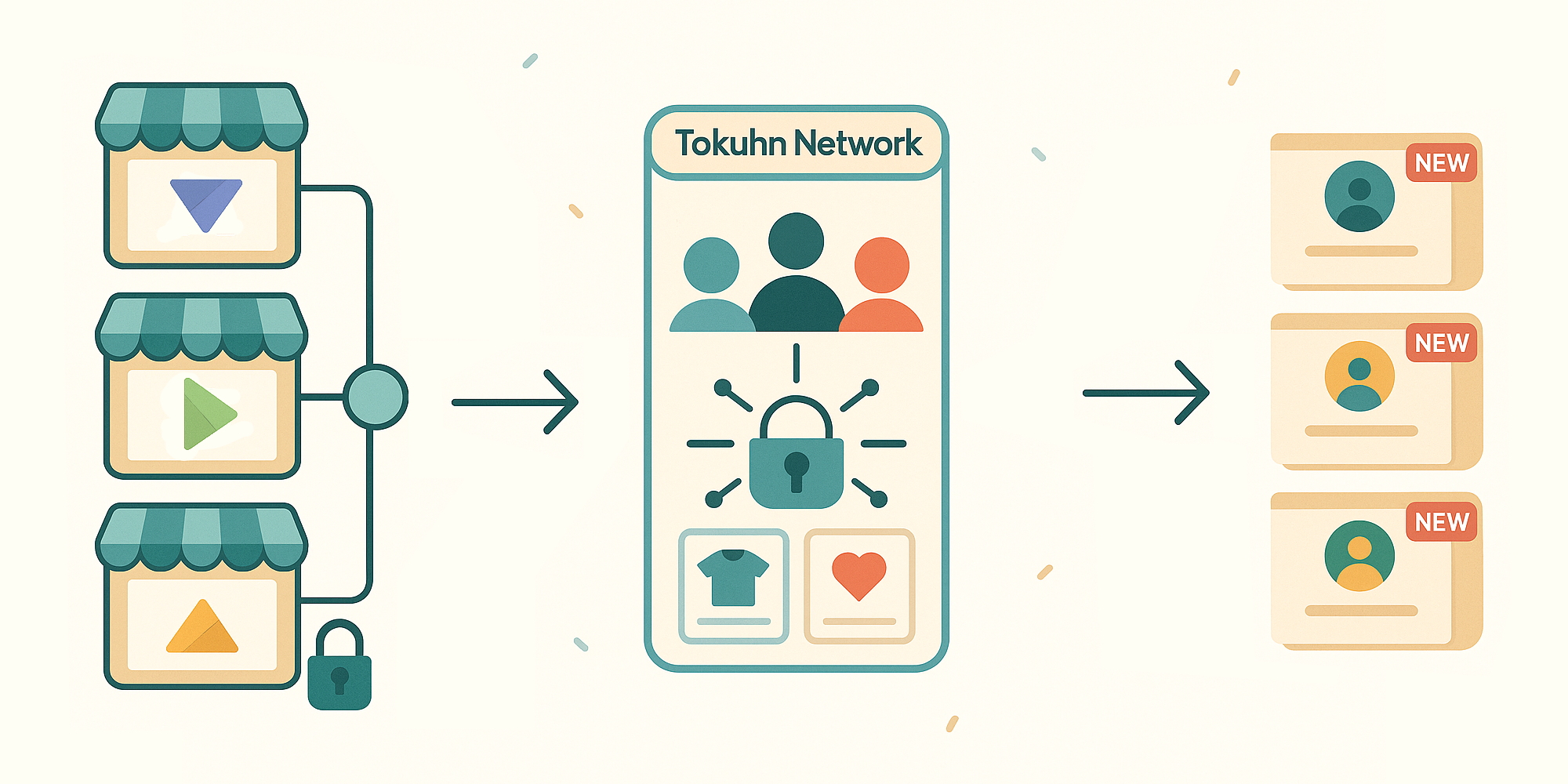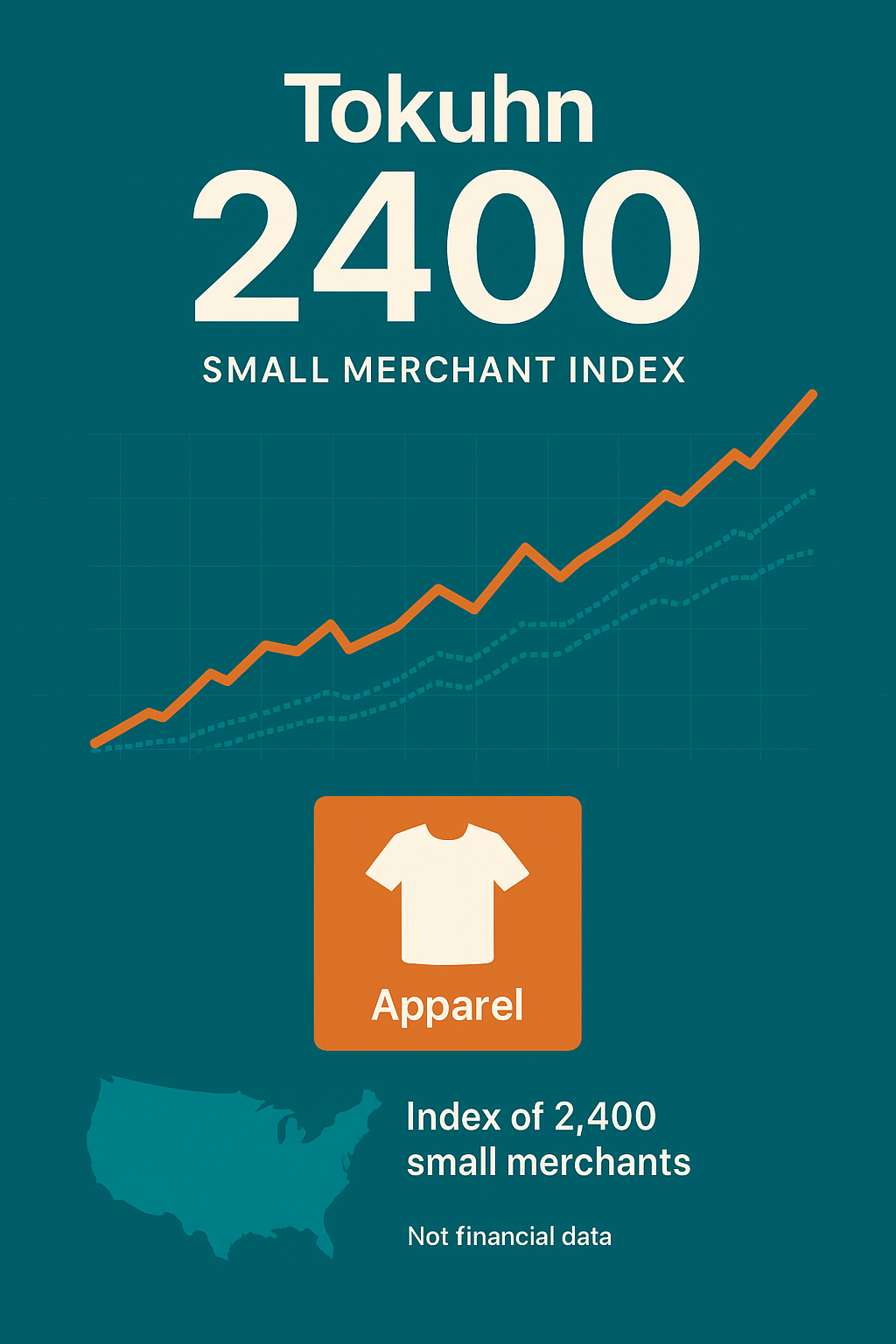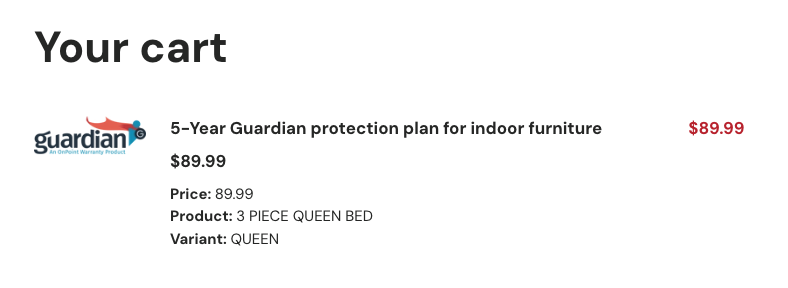Your Brand, Your Colors

Acquire
FashionPop uses Google-verified sign-in to capture customers' best emails and turn more visits into conversions. Sell
Tokuhn Threads predicts who is ready to buy, so you can send the right offer to the right customer at the right time. Grow
Reach new buyers through Tokuhn Network. You pay only when you gain a new customer, and you keep the data. Thrive
Tools and insights powered by Tokuhn 2400 benchmarks, in-house research, as well as Coalesce® and Precipitate® to turn signals into better results for merchants. Acquire
Sell
Grow
Thrive
Build
# Acquire
Get Leads You Can Actually Convert #
"Am I effectively acquiring leads, or am I just lighting margin on fire?"
The cards in this section answer that question. You'll see calculators, trust checklists and IYKYK cards that help point out how you can improve acquisition. You may also see Problem Solver cards that highlight apps that solve specific issues.  AD PREFLIGHT
AD PREFLIGHT

Ad Readiness: Max CPC Check #Enter your estimated Revenue Per Visitor (RPV) and target buffer (aim for 2-3x based on 2025 benchmarks). 2025 Benchmark: Avg e-com RPV ~$1.80-3; if your max CPC > $1.16 (Google) or $0.63 (Meta), you're likely ready to test ads. Otherwise, boost RPV first! ! IYKYK
It is not you, it is them.
#
Most popular Shopify apps are not built for your
scale, so they focus you on the wrong things.
If you tried popular Shopify apps and felt let down, here is the truth: most were not designed for merchants like you. A low-priced tier is often a de-featured version of an enterprise product, not a tool built around small-merchant constraints. Read more
If you tried popular Shopify apps and felt let down, here is the truth: most were not designed for merchants like you. A low-priced tier is often a de-featured version of an enterprise product, not a tool built around small-merchant constraints. Enterprise gravity creates three traps: features that miss your real problems, roadmaps aimed at big-brand priorities, and benchmarks that assume high traffic and make healthy small-store numbers look broken. You end up pushing buttons without getting outcomes. If the promised results are not showing up, or doing more inside the tool does not move the needle, switch to software designed for your inputs from the start: your traffic, your list size, and your time budget.  Problem Solver
Problem Solver
Tokuhn Network #"Tokuhn is our lowest-cost acquisition channel. We only pay when a sale happens, so we can put offers in front of the entire network without worrying about wasted spend." - Raul Hadema, Convoy Car Care
Get distribution without buying clicks. Tokuhn puts your offer in front of qualified shoppers across the network and you only pay when they actually convert. This is how you scale acquisition safely. You get reach. You get new buyers. You're never upside down on ad spend because you're not paying for attention, you're paying for sales.  OFFER READY
OFFER READY
Offer Clarity Check #The goal is not to close the sale in one hit. The goal is to earn the right to follow up. If this list is not clean, do not expect the first send to convert. The job of the first send is to open the door. ! IYKYK
Sometimes the question is whether to buy ads at all.
#
Ads buy attention, not sales. Use this simple process
before you spend.
The right question is often not how to optimize ad spend, but whether to spend at all. Ads buy attention, not sales, and if your store cannot turn visits into orders at a high enough rate, ad dollars will lose money regardless of scale. Read more
The right question is often not how to optimize ad spend, but whether to spend at all. Ads buy attention, not sales, and if your store cannot turn visits into orders at a high enough rate, ad dollars will lose money regardless of scale. Run a profit check with four inputs: expected cost per click, click to visit ratio, site conversion rate, and contribution per order defined as AOV minus direct costs. The go or no-go rule is simple: conversion rate multiplied by contribution per order should be greater than or equal to cost per click. If the result is positive, proceed and monitor weekly. If it is negative, ask three questions: am I buying to learn and I know this run will not be profitable, am I buying repeat-friendly products with quick payback, or am I clearing inventory that loses value each week. If none apply, improve merchandising to raise conversion and improve gross profit by adjusting price or costs before buying media. Bottom line, ads buy attention and your store creates profit. Spend when the calculator is positive or the learning or inventory case is worth it. Otherwise, invest in conversion and margin first. ! IYKYK
You do not need more emails, you need better ones.
#
Low-quality leads kill your list. Here is how to fix
it without gimmicks.
If your list feels dead - low opens, no clicks, spam complaints - you are not imagining it. Most popups chase quantity with spin wheels, exit-intent triggers, and loud designs with hidden close buttons, so you get junk emails and zero engagement. Read more
If your list feels dead - low opens, no clicks, spam complaints - you are not imagining it. Most popups chase quantity with spin wheels, exit-intent triggers, and loud designs with hidden close buttons, so you get junk emails and zero engagement. Here is what is actually happening: traditional popups are optimized for volume, not outcomes. They trade poor offers for poor emails and accept anything typed into the box. The result is throwaway addresses, fake accounts, and no intent to buy, so you end up with a list that looks big and performs like it is empty. Every fake email hurts your sender score, your real subscribers get fewer emails, your reputation tanks, and your best content goes to spam. A better list starts with verified emails captured via Google Sign-In or Apple, exchanged for a stronger offer that justifies a real address. Those leads open, click, and convert because they are real. No tricks and no bait. Provide enough value to earn a real email, and if you want more sales, stop chasing any email and capture the best. Path to Low-Quality Emails #
"Spin-to-win popups and generic 10% offers collect junk inboxes that never buy and
get you flagged as spam."

 Problem Solver
Problem Solver
FashionPop #"FashionPop gives us real emails that actually open. We trade a strong first offer, and in return we get the customer's primary inbox, not fake accounts and not junk addresses." - Rachel, Columbia Leather Store
FashionPop is list building that isn't garbage. You make an offer that matters, and in exchange the shopper gives you the email they actually check. You walk away with real, warm contacts you can sell to again. If your list is full of trash emails, your offers never land. FashionPop fixes that. You're not guessing who to market to - you're in their real inbox on day one.  TRAFFIC BUY CHECK
TRAFFIC BUY CHECK
Paid Traffic Readiness #If any of these fail you are likely lighting ad spend on fire. If you cannot check all boxes, fix the page and the capture before you raise spend. Do not try to outbid a broken offer. ! IYKYK
10% off for everyone is worse than 30% off for a few.
#
Blanket discounts hurt pricing power and convert less.
Targeted incentives close more and cost less.
Many stores default to 15% off sitewide and wonder why conversions stall. A weak discount for everyone does less than a strong offer for the right few, because small, permanent markdowns train customers to ignore urgency and distrust full price. Read more
Many stores default to 15% off sitewide and wonder why conversions stall. A weak discount for everyone does less than a strong offer for the right few, because small, permanent markdowns train customers to ignore urgency and distrust full price. Offer 30% off to a well-chosen 20% instead. It hits harder, feels earned, and preserves pricing power while avoiding margin burn across the base. Promotion is about relevance, and merchandising is about trust, so a precise, targeted incentive does both jobs better. Stop treating 15% as a default. Use Acquire and Promotion to build segments, then send the right offer at the right time. How you discount matters more than how much. ! IYKYK
Your offer is the resume. The email is the interview.
#
Offers do not close sales. They open doors.
Most new customers do not buy right away. They come back two or three times if you are lucky. The offer is not the closer; it is the resume. It gets you noticed, earns attention, and wins permission to follow up. Read more
Most new customers do not buy right away. They come back two or three times if you are lucky. The offer is not the closer; it is the resume. It gets you noticed, earns attention, and wins permission to follow up. The sale is created by two systems working together: a strong email sequence that builds trust and timing, and merchandising that reinforces belief and desire on the site. If offers are not converting, it often means you expect the offer to do a job it was not built to do. Let the offer earn the email, then let the emails earn belief. Keep the door open with consistent follow-up so that when the moment is right, the purchase is easy. The resume gets you in the door; the interview gets the job. Capture Verified Leads
Google Sign-In
10-30% Coupons
Turn Visitors Into CustomersFashionPop converts more visitors at the moment of intent: Google Sign-In plus instant coupon equals more real, marketable customers in your Shopify store. Clear Value
No Exclusions
30-Day Timer
Coupons That ConvertPick 10%, 20%, or 30% off. Shoppers understand it instantly and redeem; simple, trustworthy, and effective. Shopify Sync
Marketing Opt-In
Clean Data
Own Your Customer DataEvery signup is for a unique customer with marketing opt-in and a clear tag for segmentation. No third-party list control. # Sell
Make the Offer Make Sense #
"Does the offer feel clear, fair, and safe, will it convert?"
This section answers that question. You'll see checklists that make your offer believable, and calculators that show what a discount really does to your margin (and how hard conversion now has to work to break even). You'll also see Problem Solver cards that add trust signals so you don't have to lean on "20% off" every time you want someone to click Buy. Strong Offer = Their Best Email #
"If the offer is real, no exclusions, no hoops, they'll give you the inbox they
actually read."

! IYKYK
10% off for everyone is worse than 30% off for a few.
#
Blanket discounts hurt pricing power and convert less.
Targeted incentives close more and cost less.
Many stores default to 15% off sitewide and wonder why conversions stall. A weak discount for everyone does less than a strong offer for the right few, because small, permanent markdowns train customers to ignore urgency and distrust full price. Read more
Many stores default to 15% off sitewide and wonder why conversions stall. A weak discount for everyone does less than a strong offer for the right few, because small, permanent markdowns train customers to ignore urgency and distrust full price. Offer 30% off to a well-chosen 20% instead. It hits harder, feels earned, and preserves pricing power while avoiding margin burn across the base. Promotion is about relevance, and merchandising is about trust, so a precise, targeted incentive does both jobs better. Stop treating 15% as a default. Use Acquire and Promotion to build segments, then send the right offer at the right time. How you discount matters more than how much.  LIST HEALTH
LIST HEALTH
Deliverability / List Quality#If you fail here, your emails will quietly die in junk and your promos will look "flat" even if the offer is good. If you can't check these, fix list quality before blaming "email is dead."  Problem Solver
Problem Solver
Brand Bench CRO Report #
Brand Bench reviews your store the way a head of growth would and gives you a
conversion report.
It benchmarks you against thousands of independent merchants, not generic best
practices.
The report covers trust signals, retargeting setup, landing page clarity, PDP copy,
merchandising, and more.
! IYKYK
The Rule of 7 does not mean what you think it does.
#
If your open rate is 14%, it is not 7 emails. It is
49.
You have heard it before: it takes 7 touches to make a sale. Those touches are opens, not sends, and the difference is massive. If your open rate is 14%, you do not need 7 emails; you need 49, because 7 divided by 0.14 is 49. Read more
You have heard it before: it takes 7 touches to make a sale. Those touches are opens, not sends, and the difference is massive. If your open rate is 14%, you do not need 7 emails; you need 49, because 7 divided by 0.14 is 49. This reframes progress. If you have sent 14, 21, or 35 emails without results, you may be halfway, not failing. Many merchants quit at the moment they should double down, assuming the audience is uninterested when the sequence simply needs more opens. Campaigns usually fail because follow-up stops too soon, not because the offer is weak. Keep sending, keep building trust, and keep earning attention. When the seventh open finally happens, you will be the one they remember. ! IYKYK
Swap junk emails for revenue recovery.
#
A one-time strong offer can clean your list and boost
engagement, without turning you into a discount machine.
If your email deliverability is tanking - more junk folder landings, lower opens, stalled sales - you are not stuck. The fix is not more sends or weaker incentives. It is upgrading your list quality with a smart exchange. Read more
If your email deliverability is tanking - more junk folder landings, lower opens, stalled sales - you are not stuck. The fix is not more sends or weaker incentives. It is upgrading your list quality with a smart exchange. Here is the truth: most stores have bloated databases. Say you have 3,000 contacts; 1,500 to 2,500 might be low-quality, throwaways, inactives, or unverified emails that drag down your reputation. Reach out to your existing list with a strong, one-time offer: 30% off in exchange for a verified email such as Google or Apple sign-in. Why does this work? It is a clear value trade: they get a premium discount, and you get authenticated, high-engagement contacts. Those verified emails drive better opens and clicks, repairing your inbox placement over weeks with a steady cadence. Week one, fresh engagement starts. Week two, deliverability improves. Week three, revenue climbs as real buyers respond. It also rewards your install base without endless promos, limiting the always-on-sale vibe that erodes pricing power. What to do about it: segment low-engagement contacts, send one email that says "Upgrade your perks - share your verified email for 30% off now," and track the uplift as opens rise, junk rates drop, and sales recover. It is not about growing junk mail; it is about recovering what is yours with emails that actually work. Recover Real Emails You Can Actually Reach #
"Send a targeted offer that asks contacts to confirm with their Google-authenticated
inbox. You pull them
back into a real, deliverable email and unlock revenue sitting in your 'dead' list."

 AD PERFORMANCE
AD PERFORMANCE

Ad Performance: ROAS vs. RPV/CPC#Input your ROAS (e.g., 4 for 4:1), RPV, and CPC to check if ratios align (RPV/CPC should typically exceed ROAS). 2025 Benchmark: Avg e-com ROAS 2.87-4:1; if RPV/CPC isn't higher, audit attribution.  TRUST CHECK
TRUST CHECK
Trust Before Conversion#Quick pass/fail checklist. If you miss any of these, your conversion rate will suffer even if your offer is good. If you cannot check all of these, fix trust before buying traffic.  Problem Solver
Problem Solver
Instant Trust: Extended Coverage #"Guardian has transformed how we offer protection. We went from single-digit attach rates to over three times that number. It's a seamless fit for our Shopify store and a major win for both our customers and our bottom line." - Sid Mollai
Co-Founder, Bel Furniture
If shoppers hesitate because they are not sure they can trust you yet, Guardian adds real protection right on PDP / cart. You get conversion lift and upsell dollars, shoppers get peace of mind. This is how you look legitimate in the first 7 seconds, not after they dig through policy text. ! IYKYK
You have got 7 seconds.
#
Trust and appeal decide what happens next.
Most visitors are not your buyer, and that is fine, but every visitor judges fast. First, do I trust this store. Second, can I see why these products might appeal to someone, even if not me. If either answer is no, they are gone and they will not open your next email. Read more
Most visitors are not your buyer, and that is fine, but every visitor judges fast. First, do I trust this store. Second, can I see why these products might appeal to someone, even if not me. If either answer is no, they are gone and they will not open your next email. You do not need instant conversion; you need instant belief. Belief earns curiosity, and curiosity keeps the door open. A hiking stick does not have to sell a non-hiker; it only has to spark the thought that it would be perfect for someone they know. Nail the first impression and every follow-up gets easier. Miss it and you are cold again. Make them trust you and believe that someone will care within those first 7 seconds.  REPEAT DRIVER
REPEAT DRIVER
Second Order Plan#This is how you turn a one time buyer into a customer. If you cannot check these boxes, you are buying every order like it is the first order forever. ! IYKYK
Trust first, returns second or risk failing quietly without sales.
#
Big brands obsess over returns. Small stores win by
building trust first.
Many small Shopify merchants chase return reductions from day one and then wonder why sales never take off. Trust is what gets shoppers to say yes; returns are something you tune after orders are flowing. Read more
Many small Shopify merchants chase return reductions from day one and then wonder why sales never take off. Trust is what gets shoppers to say yes; returns are something you tune after orders are flowing. Without trust, no policy tweak converts a hesitant visitor. Trust lifts opens, clicks, and buys across every step, and returns only matter after you have won the sale. Virtually no small store fails from high returns; they fail from low sales amplified by low trust. Lead with trust and make the return promise short, plain, and visible everywhere. Use one line such as "Free 30-day returns," put it on the first screen of emails and above the fold on pages, and repeat it in cart and checkout. Do not hide it, complicate it, or bury it for creative space. Check it before every campaign and recheck monthly. Nail visibility on returns to earn the first yeses, grow sales, and then tune details later.  Problem Solver
Problem Solver
Turn Returns Into Revenue #"This app has provided us a simple way to manage open-box clothing and accessories, which is a smaller part of our overall business but it helped us quickly list a few returned and lightly damaged items. The team was helpful and quick to respond when we had questions!" - Golden Hour Farm
Returns and open-box items do not have to be a loss. Pharaoh lets you resell them on your own site as Open Box instead of writing them off. You already paid CAC for these products. Pharaoh just lets you get that value back.  COALITION VALUE
COALITION VALUE

Coalition Value (2.7% network fee on every sale) #Enter the first order value and your estimated LTV. The calculator shows total network fees on attributed revenue, first order net after the 2.7% fee, lifetime net after fees, and the LTV to fees multiple. Benchmark: With a 2.7% fee on all attributed sales, the first order nets 97.3% of revenue. A healthy result keeps lifetime net after fees clearly positive and shows a strong LTV to fees multiple.  MARGIN PROTECT
MARGIN PROTECT
Offer Profit Safety Check#Use this before you run a sale or send an aggressive offer. If this fails, do not scale that offer. You will move units and make no money. ! IYKYK
The trust checklist to run before you hit send.
#
8 quick pass-fail checks that prevent lost orders and
refunds
Trust wins orders, so run a 2-minute pass-fail before any promotion. Confirm that the email, landing page, and site look professional and consistent in branding, colors, voice, tone, fonts, and product claims, and verify that prices never rise along the journey from ad or email to PDP, cart, and checkout. Read more
Trust wins orders, so run a 2-minute pass-fail before any promotion. Confirm that the email, landing page, and site look professional and consistent in branding, colors, voice, tone, fonts, and product claims, and verify that prices never rise along the journey from ad or email to PDP, cart, and checkout. Ensure the coupon or offer is frictionless and honest, with auto-apply or one tap, that it works on the promoted items including sale items or that any exclusions are clearly stated in the first screen, and that the final price matches the promise with no gotchas. Put a clear shipping and return promise in the first screen, keep store name and visuals consistent from email to landing page, and place real product photos above the fold. Position ratings with review count near the CTA and add one short, specific review snippet close to the buy zone. When every line passes, send. If any line fails, fix it first. Expand Your Reach with Tokuhn Network



Tokuhn Network connects small e-commerce merchants with a broader audience. By joining the network, you tap into a community of customers eager to discover new brands and support small businesses. No Upfront Costs, No Monthly Fees



Pricing: 2.7% of every non-returned purchase from customers we introduced. No monthly fees. No upfront costs. Tokuhn points drive purchases across the network.



With Tokuhn Points, customers earn rewards they can use at any merchant in the network, encouraging them to come back and make repeat purchases with trusted brands. Keep Customer Data in Your Hands



Tokuhn Network allows you to retain full control of your customer relationships and data, empowering you to build lasting connections without third-party interference. Specifically Designed for Small Merchants



Our platform is built with the needs of small e-commerce merchants in mind, offering a simple, affordable way to grow without complex integrations or high costs. # Grow
Win the First Order Without Bleeding Out #
"Can I afford to buy this customer at all and still survive the first order?"
This section is about acquisition economics. You only get one first purchase. If that purchase loses too much money, scaling will break you. You'll see calculators that tell you your true CAC ceiling on order one, and where you're quietly losing margin to fulfillment, returns, and incentives. You'll also see Problem Solver cards that turn hesitation into recovered dollars. ! IYKYK
Why the vendor's advice does not seem to work for my store.
#
Your vendors want you to win, but big-merchant gravity
shapes their playbooks.
This is not about bad actors. Most vendors want you to succeed and care about your results. The issue is gravity that pulls inputs from the largest customers and projects them as general guidance. Read more
This is not about bad actors. Most vendors want you to succeed and care about your results. The issue is gravity that pulls inputs from the largest customers and projects them as general guidance. Market research interviews the biggest accounts, product research prioritizes their requests, case studies showcase eye-catching logos and numbers, and benchmarks are drawn from high-traffic stores. None of that is malicious; it is simply where the data and ROI live, but it creates a mismatch for smaller stores. When lessons are extracted from large-merchant inputs, the guidance is often off, wrong, or even inverted for most merchants. The fix is to use guidance built for your category, size, and maturity, and to be comfortable replacing vendor conventional wisdom when it does not fit. This does not mean the vendors are wrong. It means their insights may not apply to your inputs, constraints, or outcomes.  TRAFFIC GATE
TRAFFIC GATE

Breakeven CPC Gate#Can you afford to buy paid clicks right now. If expected value per click is lower than cost per click, stop. Rule: conversion_rate_decimal x contribution_per_order should be greater than or equal to CPC.  Problem Solver
Problem Solver
Brand Book Powered by Coalesce® #
Brand Book creates trust-building documents for your store using our Coalesce®
platform.
The output is not copy ideas, it's an aligned system: how you talk, what you
promise,
and how you show up everywhere (site, emails, PDPs, support, ads).
When every surface sounds like the same company, same mission, same tone, same value
prop -
customers trust you faster. That is a conversion lift. It's also a return-rate
reducer.
 CHECKOUT FRICTION
CHECKOUT FRICTION
Cart / Checkout Pass-Fail #If any of these are broken, you are paying for traffic just to watch it stall at the pay button. If this fails, fixing the checkout leaks is higher ROI than buying more traffic.  DISCOUNT LIFT
DISCOUNT LIFT

Discount Margin and Lift#Check how much profit per order you keep after a discount and how much harder the page now has to convert. If required lift is 1.4x, that means you now need 40 percent more conversions just to tie.  CAC CEILING
CAC CEILING

First Order CAC Ceiling#How much can you spend to win a brand new customer on order one and still be safe. Reference model: 30 percent of first order, capped at 25 dollars, paid once for a new customer only.  REPEAT VALUE
REPEAT VALUE

Second Order Value #This tells you how much profit is left after 2 orders and whether your win-back incentive is still safe. If you stay net positive after two orders, you can justify real incentives to bring them back.  Problem Solver
Problem Solver
Tokuhn Shop #Tokuhn Shop is free for the merchant. It's built as an endless boutique for independent brands, shoppers browse products from 1,500+ merchants in one place. Examples live in Tokuhn Shop right now:
Ember Street Co., IronPeak Labs, Finch Carry, Nightshift Coffee Co., Bark & Foundry, North Ridge Gear, Quiet Kiln Studio, Luma Field Skin, Violet Harbor Jewelry, Second Run Denim, Everkiln Ceramics, Driftwood Provision Co., Arc & Alder Tools, Field Theory Botanicals, Ghost Shift Moto Care, Saltline Swim, Tiny Forge Pet Hardware, Bramble & Beam Home, Apex Trail Supply, Honeytone Wellness Add a new acquisition surface without buying cold clicks. Let shoppers find you while they're already looking at products like yours. ! IYKYK
The customer drop-off you are worried about is not the one that is killing you.
#
Monitor churn at the bottom. Fix losses at the top.
That is where the leverage is.
Many teams obsess over post-purchase churn, but the bigger leak happens before the first order. Acquisition fails when junk opt-ins cannot be reached, promotion fails when messages are off-time or off-message, and merchandising fails when the site does not help a visitor choose with confidence. Read more
Many teams obsess over post-purchase churn, but the bigger leak happens before the first order. Acquisition fails when junk opt-ins cannot be reached, promotion fails when messages are off-time or off-message, and merchandising fails when the site does not help a visitor choose with confidence. This pre-order drop-off quietly kills growth. With 50,000 impressions, 5,000 opted-in contacts, 1,000 orders, and a 2.5% repurchase rate, a 10% lift that flows through to first orders adds around 100 new orders, while a 10% lift in repurchases only adds a few. If they never buy once, there is nothing to grow. Do not skip straight to Grow. Earn Grow by passing the first test: turn a curious visitor into a real customer, then improve repurchase once the base is healthy. ! IYKYK
You are not doing it wrong. You are just not a rocket ship ... yet.
#
Most expert advice is built on exceptions, not the
average.
If expert advice has not worked for your store, you are not alone. You are likely not doing it wrong. Podcasts, blogs, and conferences reward dramatic stories, and good stories lean on turning points, exceptional outcomes, and simple takeaways. Read more
If expert advice has not worked for your store, you are not alone. You are likely not doing it wrong. Podcasts, blogs, and conferences reward dramatic stories, and good stories lean on turning points, exceptional outcomes, and simple takeaways. That is the trap. They treat the exception as the average and present it as a roadmap. Your store is probably not a rocket ship, and most stores are not. Most merchants are grinding, earning every visitor, every open, and every dollar. When those tips do not work, it is usually because the strategy assumes magic inputs you do not have. Focus on the boring basics that compound: sustainable cadence, predictable improvement, and discouragement-free execution. That is what builds real progress when you are not the exception. Discover with Delight



Venture into a world where every item has a story and every purchase supports a dream. At Tokuhn, we curate an inspiring selection of goods from small but mighty merchants with hearts as big as their ambitions. Small brands with grand visions



Small brands with grand visions find a home at Tokuhn. We believe in the power of community, the spark of innovation, and the strength in collaboration. If you are ready to unfold your brand's potential and share your craft with a captivated audience, we are here to amplify your voice. Your insights light the way



Share your voice. Tell us about the features that excite you, the experiences that delight you, and the dreams you envision for our community. Your input is the cornerstone of our growth. Our Promise to You



Tokuhn was crafted to be a sanctuary for small brands with big dreams. We are not just a platform. We are a partnership, a community, and a family. Tell us your story, share your passion, and let's make magic happen together. We are here for you every step of the way. 


Tokuhn Network CampaignsCo-market across indie brands with context, so you reach new buyers without spam. 


Tokuhn ThreadsPredict who is ready to buy, make the right offer, and protect your margins. # Thrive
Operate Like You're Not Alone #
"Am I making the right moves or am I just guessing in the dark?"
Thrive is about leverage. Not just "more sales," but smarter decisions, faster. This section pulls from Tokuhn's network and the Tokuhn 2400' real performance data from stores like yours' so you can see what's actually working in the wild instead of guessing. It's not theory. It's signal. You'll also see tools built on our AI platform that help you apply those insights across every pillar.  Problem Solver
Problem Solver
Tokuhn Product Dataset #
We publish TSMPD-US-Public-v1_1, an open product dataset designed so independent
brands can show up in AI shopping results.
So far, it has been downloaded more than 2,000 times and includes over 67 million
products
from 355,000 indie merchants. That means AI systems that pull from this data can
recommend indie products at scale.
Adding your catalog means your products become eligible to surface when someone asks an AI assistant "what should I buy?". ! IYKYK
Trust first, returns second or risk failing quietly without sales.
#
Big brands obsess over returns. Small stores win by
building trust first.
Many small Shopify merchants chase return reductions from day one and then wonder why sales never take off. Trust is what gets shoppers to say yes; returns are something you tune after orders are flowing. Read more
Many small Shopify merchants chase return reductions from day one and then wonder why sales never take off. Trust is what gets shoppers to say yes; returns are something you tune after orders are flowing. Without trust, no policy tweak converts a hesitant visitor. Trust lifts opens, clicks, and buys across every step, and returns only matter after you have won the sale. Virtually no small store fails from high returns; they fail from low sales amplified by low trust. Lead with trust and make the return promise short, plain, and visible everywhere. Use one line such as "Free 30-day returns," put it on the first screen of emails and above the fold on pages, and repeat it in cart and checkout. Do not hide it, complicate it, or bury it for creative space. Check it before every campaign and recheck monthly. Nail visibility on returns to earn the first yeses, grow sales, and then tune details later. ! IYKYK
The trust checklist to run before you hit send.
#
8 quick pass-fail checks that prevent lost orders and
refunds
Trust wins orders, so run a 2-minute pass-fail before any promotion. Confirm that the email, landing page, and site look professional and consistent in branding, colors, voice, tone, fonts, and product claims, and verify that prices never rise along the journey from ad or email to PDP, cart, and checkout. Read more
Trust wins orders, so run a 2-minute pass-fail before any promotion. Confirm that the email, landing page, and site look professional and consistent in branding, colors, voice, tone, fonts, and product claims, and verify that prices never rise along the journey from ad or email to PDP, cart, and checkout. Ensure the coupon or offer is frictionless and honest, with auto-apply or one tap, that it works on the promoted items including sale items or that any exclusions are clearly stated in the first screen, and that the final price matches the promise with no gotchas. Put a clear shipping and return promise in the first screen, keep store name and visuals consistent from email to landing page, and place real product photos above the fold. Position ratings with review count near the CTA and add one short, specific review snippet close to the buy zone. When every line passes, send. If any line fails, fix it first.
Tokuhn Coalesce®
Coalesce is one component of our AI platform that addresses a core limitation of LLMs. LLMs are built to emit the most predictable next word-great for fluid experiences, but it can lead to false precision. Coalesce replaces the loudest opinion with expert guidance. The Hackathon SparkIn 2023, Tokuhn's founders challenged the status quo at our first hackathon. Frustrated by crowdsourced noise producing popular guesses instead of precise solutions, we asked: can AI channel expert wisdom instead? The answer was Coalesce. The Expert CoalitionBuilt with insights from enterprise and e-commerce leaders, Coalesce fuses curated expertise into a decision layer that reduces overconfident errors and delivers tailored strategies for e-commerce success.
Tokuhn Precipitate®
Precipitate is a component of our AI platform that distills patterns from sparse signals, aggregating behaviors across the merchant network into a global model. It provides foundational predictions derived from network-wide patterns. The Inspiration SparkWe asked: could we adapt lessons from TikTok's algorithm to e-commerce? The result was Precipitate, turning network-level patterns into scalable AI infrastructure for indie e-commerce. The Global CoalitionInspired by advances in scalable embeddings and online training, Precipitate fuses sparse merchant data into a resilient platform. It handles long-tail behaviors-like infrequent buys or seasonal trends-while preserving privacy, delivering the backbone for data-driven predictions. Tokuhn 2400 - Research & Benchmarks



The Tokuhn 2400 distills patterns across indie merchants, finding where spend is wasted, what reliably moves CVR, and how to sequence offers, trust, and network reach for compounding lift. Key insights we publish



Free tools - Brand Bench & Brand Book



Brand Bench gauges your store against 4,000+ shops, exposing sales killers with sharp insights. Ignite growth with tactics that convert clicks into loyal buyers. Brand Book crafts your unified brand with dynamic strategies and definitions. Spark trust and loyalty with a voice that connects across every customer touchpoint.  Problem Solver
Problem Solver
Public Shopify Apps #"Tokuhn helped us turn our idea for Pharaoh reselling open-box and returned items instead of writing them off into a fully functional Shopify service. Now any merchant can unlock margin from open-box inventory without custom code." - Luke, Pharaoh
Some businesses shouldn't just pitch merchants; they should live inside the
merchant's store.
! IYKYK
One size does not fit your store. Build what does.
#
Some merchants have unique challenges and unique
ideas.
Off-the-shelf tools do not always solve them.
Most apps are built for the median merchant. If your store has unusual catalog rules, bundling, pricing, fulfillment, or buyer behavior, the one-size approach caps your outcome. Read more
Most apps are built for the median merchant. If your store has unusual catalog rules, bundling, pricing, fulfillment, or buyer behavior, the one-size approach caps your outcome. Tokuhn builds focused Shopify apps to solve the specific thing holding you back. We align to your funnel work: Acquire, Sell, Grow, Thrive, and implement only what moves your metrics. Examples include verified email capture without gimmicks, price-guarantee logic, coalition points and offers, POS line-item actions, store-branded protection, or a feature that exists only in your head today. The result is an edge your competitors cannot download, with data and workflow that match how you operate. One size does not always fit all. When you have a unique challenge or a unique insight, build what is yours.  Problem Solver
Problem Solver
Custom Revenue Apps #"Tokuhn built a Shopify app that lets our partner offer warranties inside their stores; right in the flow, no engineering required on their side. We went from "can you do this?" to "it's live and making money fast." - Jackie, OnPoint Warranties
Guardian asked us to build a custom app their Shopify partner could use to sell
protection
plans. We packaged the offer, wired the warranty, and shipped
an app the partner could turn on and start selling.
This is what we do for partners: take an idea
and turn it into something that solves their problems.
|



The Tokuhn NetworkThe Tokuhn Network empowers small merchants by connecting them to new customers while ensuring they retain control over their data and relationships. Grow affordably and confidently with no upfront costs or monthly fees. 


Earn Valuable PointsConsumers earn Tokuhn Points with every purchase at network merchants, redeemable across stores for discounts. Make every transaction more rewarding while supporting independent brands. 


Build Loyalty Across StoresWith Tokuhn Points, customers can redeem rewards at any network store, driving repeat purchases and loyalty to small, independent brands. 


Expand Your ReachTokuhn Network provides visibility across a wide audience of customers who value small, independent brands. Reach more people eager to discover unique products and support local businesses. Acquire New Customers
No Upfront Costs
Join A Community
Ignite Your PassionDiscover curated collections at the Tokuhn Shop, where every search leads to intentional finds and delightful surprises. Start your journey today and uncover the unexpected. Acquire New Customers
No Upfront Costs
Join A Community
Meet the MakersAt the Tokuhn Shop, every item has a story. Celebrate the artisans and entrepreneurs behind your favorite finds and experience the soul in every product. Acquire New Customers
No Upfront Costs
Join A Community
Search with SofiaSofia, your AI shopping assistant, is here to guide you through the Tokuhn Shop. Let her help you find treasures that support small brands with big dreams. Acquire New Customers
No Upfront Costs
Join A Community
Discover with DelightVenture into a world of stories and dreams. The Tokuhn Shop connects you with small merchants and their inspiring creations, making every purchase a meaningful experience. |
Install

Tokuhn NetworkAcquire New Customers
No Upfront Costs
Join A Community
Ad Network for Indie MerchantsTokuhn Network sends proven indie buyers to your store. It is inexpensive, predictable, and simple. No budgets or bids. Retargeting is included as a feature to finish more checkouts.
What is the Tokuhn Network?Tokuhn is an ad network for indie brands. Shoppers use Tokuhn points to claim your offer, then buy on your site. You keep the customer and the data. Ad NetworkTokuhn brings first-time buyers to your store. Shoppers use Tokuhn points to claim your welcome offer, then check out on your site. You keep the customer and the data. Pricing is simple: pay 2.7% on every non-returned purchase from customers we introduce. No monthly fees. No upfront costs. You control the offer. New CustomersTap into the Tokuhn Network to reach buyers who would not find you on their own. We send ready-to-shop consumers to your store. No upfront costs. Orders happen on your site. You keep the data. Install, set your offer, and go live in minutes. Affordable GrowthGrow without burning cash up front. Tokuhn is a performance ad network for indie brands with no monthly fees and no setup costs. You pay 2.7% only after a non-returned purchase from a customer we introduced. Orders happen on your site and you keep the data. Install, set your offer, and go live in minutes. Data ControlWith the Tokuhn Network, you maintain complete control over your customer data and relationships. Unlike many affiliate-style programs, where customer information is retained by the platform, Tokuhn ensures that every purchase is made directly on your Shopify store. This means you gain valuable customer insights, build your own database, and foster meaningful connections for future marketing and sales. Tokuhn helps you grow your customer base without sacrificing control or independence. Expand Your Reach with Tokuhn Network
Tokuhn Network connects small e-commerce merchants with a broader audience. By joining the network, you tap into a community of customers eager to discover new brands and support small businesses. No Upfront Costs, No Monthly Fees
Join the Tokuhn Network at zero cost. Pay only when you gain a new customer, making this the most affordable acquisition channel for small merchants striving to grow. Build Customer Loyalty Across Brands
With Tokuhn Points, customers earn rewards they can use at any merchant in the network, encouraging them to come back and make repeat purchases with trusted brands. Keep Customer Data in Your Hands
Tokuhn Network allows you to retain full control of your customer relationships and data, empowering you to build lasting connections without third-party interference. Specifically Designed for Small Merchants
Our platform is built with the needs of small e-commerce merchants in mind, offering a simple, affordable way to grow without complex integrations or high costs. |
Install

Verified Leads



Google Sign-In Coupons That Convert



Standard Coupons Auto-Recognize Returning Shoppers



10-20%
Lead capture lift
4×
More Primary Emails
$4.99
Unlimited leads / mo
Setup



Step 1. Add the app. Why Merchants Choose FashionPopPurpose-built for fashion merchants. Clear incentives for shoppers. Clean data for your CRM.
Pricing
40 leads free
Free (40 verified leads/mo) or Unlimited ($4.99/mo).
|
Tokuhn ShopAcquire New Customers
No Upfront Costs
Join A Community
Discover Unique Products at the Tokuhn ShopThe Tokuhn Shop showcases products from 1,500 small merchants. Discover hidden gems and shop directly from independent stores. Acquire New Customers
No Upfront Costs
Join A Community
Ignite Your PassionDiscover curated collections in the Tokuhn Shop, where every search leads to intentional finds and delightful surprises. Start your journey today and uncover the unexpected. Acquire New Customers
No Upfront Costs
Join A Community
Meet the MakersIn the Tokuhn Shop every item has a story. Celebrate the artisans and entrepreneurs behind your favorite finds and experience the soul in every product. Acquire New Customers
No Upfront Costs
Join A Community
Search with SofiaSofia, your AI shopping assistant, is here to guide you through the Tokuhn Shop. Let her help you find treasures that support small brands with big dreams. Acquire New Customers
No Upfront Costs
Join A Community
Discover with DelightVenture into a world of stories and dreams. The Tokuhn Shop connects you with small merchants and their inspiring creations, making every purchase a meaningful experience. |
Top PicksWhat is Tokuhn's Top Picks?Tokuhn's Top Picks allows you to showcase your best products with beautifully designed badges that enhance visibility, credibility, and urgency. With customizable styles, placements, and effects, Top Picks helps your products stand out and drives sales like never before. 
Customizable BadgesChoose from over 300 badge combinations to fit your store's style. 

Selected PlacementPosition badges in any corner and rotate them to suit your needs. 
Increased VisibilityCatch the attention of your shoppers with eye-catching designs. Elevate Your Products with Tokuhn's Top PicksBoost Sales
Enhance Product Visibility
Save Time
Customizable Options
Increase Customer Trust








Acquire New Customers
No Upfront Costs
Join A Community
Showcase Your Top PicksWith Tokuhn Top Picks, merchants can spotlight up to four products, making it easier for customers to find and purchase your best offerings.
|
Pharaoh Open-Box
Pharaoh Open-BoxVisit Pharaoh
Tokuhn Builds Shopify Apps - For Us and For PartnersWe design, build, and operate production-grade apps that help small merchants grow. Alongside Tokuhn-branded products, we also build apps for other companies as their product and engineering partner. We helped Pharaoh deliver Pharaoh Open-Box, which converts returns and open-box items into sales with grading, quick listings, and a PDP price ribbon.
Boost Revenue With
|
Guardian Protection Plans
Visit Guardian
Tokuhn builds for Guardian - production-grade apps that lift attach rateGuardian's Shopify solution makes protection plans a natural part of the purchase journey. The integration is native and fast to deploy, and the offer appears where it converts best - on the product page, in the cart, and during checkout - without adding friction. Merchants see measurable results: higher plan attach rates, a meaningful lift in warranty revenue, and a cleaner customer experience with one-click add for up to five-year protection. Implementation is measured in days, not months, and the experience stays performant at scale.
Boost revenue with plans customers actually chooseClear plan value on the PDP increases consideration early - before customers hit the cart. "Guardian made protection plans easy to understand and impossible to miss on our product pages. Attach rate lifted immediately without slowing conversions." - E-commerce Director, U.S. furniture retailer 
One-click add in cart and checkoutA frictionless, single-tap add keeps momentum high and lifts attach rate without disrupting conversion. "Adding a plan is literally a single click in the cart. It's seamless for the customer and a meaningful new revenue stream for us." - Co-founder, multi-location retailer 
Branded, transparent plan detailsA clean, brand-matched modal explains coverage in plain language so customers know exactly what they're buying. 
Right plan, right momentGuardian's selector makes it easy to compare terms and choose the best plan - no clutter, no confusion. 
|
Tokuhn Network Learning HubUnlock your e-commerce potential with Tokuhn Network's comprehensive guides. Tailored for small merchants, these resources cover loyalty programs, collaborative growth strategies, and performance insights to help you thrive. Guided Learning for Merchant Success Essential Guides for E-Commerce GrowthMastering Loyalty and Customer RetentionDive into the complexities of loyalty programs designed for small merchants. Learn how to build a program that works for your business size and how to leverage coalition gift cards to boost customer engagement. Topics Covered: Loyalty Program Strategies, Coalition Gift Cards Start GuideBuilding a Collaborative Merchant NetworkUnderstand the dynamics of collaboration among Shopify merchants. Discover strategies for maximizing profitability through joint marketing efforts, managing risk in partnerships, and unlocking growth with coalition networks. Topics Covered: Collaboration Strategies, Risk Management in Partnerships Start GuideMarket Insights and Performance OptimizationExplore data-driven insights from Tokuhn's 1,000 Merchant Cohort and quarterly observations. Learn which Shopify app categories are impacting e-commerce the most and how to manage open-box returns profitably during peak seasons. Topics Covered: Merchant Cohort Analysis, App Impact on E-Commerce, Open-Box Return Management Start GuideIf You Know You Know...or Maybe Not
! IYKYK
It is not you, it is them.
#
Ads buy attention, not sales. Use this simple process
before you spend.
The right question is often not how to optimize ad spend, but whether to spend at all. Ads buy attention, not sales, and if your store cannot turn visits into orders at a high enough rate, ad dollars will lose money regardless of scale. Read more
The right question is often not how to optimize ad spend, but whether to spend at all. Ads buy attention, not sales, and if your store cannot turn visits into orders at a high enough rate, ad dollars will lose money regardless of scale. Run a profit check with four inputs: expected cost per click, click to visit ratio, site conversion rate, and contribution per order defined as AOV minus direct costs. The go or no-go rule is simple: conversion rate multiplied by contribution per order should be greater than or equal to cost per click. If the result is positive, proceed and monitor weekly. If it is negative, ask three questions: am I buying to learn and I know this run will not be profitable, am I buying repeat-friendly products with quick payback, or am I clearing inventory that loses value each week. If none apply, improve merchandising to raise conversion and improve gross profit by adjusting price or costs before buying media. Bottom line, ads buy attention and your store creates profit. Spend when the calculator is positive or the learning or inventory case is worth it. Otherwise, invest in conversion and margin first. ! IYKYK
Swap junk emails for revenue recovery.
#
A one-time strong offer can clean your list and boost
engagement, without
turning you into a discount machine.
If your email deliverability is tanking - more junk folder landings, lower opens, stalled sales - you are not stuck. The fix is not more sends or weaker incentives. It is upgrading your list quality with a smart exchange. Read more
If your email deliverability is tanking - more junk folder landings, lower opens, stalled sales - you are not stuck. The fix is not more sends or weaker incentives. It is upgrading your list quality with a smart exchange. Here is the truth: most stores have bloated databases. Say you have 3,000 contacts; 1,500 to 2,500 might be low-quality, throwaways, inactives, or unverified emails that drag down your reputation. Reach out to your existing list with a strong, one-time offer: 30% off in exchange for a verified email such as Google or Apple sign-in. Why does this work? It is a clear value trade: they get a premium discount, and you get authenticated, high-engagement contacts. Those verified emails drive better opens and clicks, repairing your inbox placement over weeks with a steady cadence. Week one, fresh engagement starts. Week two, deliverability improves. Week three, revenue climbs as real buyers respond. It also rewards your install base without endless promos, limiting the always-on-sale vibe that erodes pricing power. What to do about it: segment low-engagement contacts, send one email that says "Upgrade your perks - share your verified email for 30% off now," and track the uplift as opens rise, junk rates drop, and sales recover. It is not about growing junk mail; it is about recovering what is yours with emails that actually work. ! IYKYK
You do not need more emails, you need better ones.
#
Low-quality leads kill your list. Here is how to fix it
without gimmicks.
If your list feels dead - low opens, no clicks, spam complaints - you are not imagining it. Most popups chase quantity with spin wheels, exit-intent triggers, and loud designs with hidden close buttons, so you get junk emails and zero engagement. Read more
If your list feels dead - low opens, no clicks, spam complaints - you are not imagining it. Most popups chase quantity with spin wheels, exit-intent triggers, and loud designs with hidden close buttons, so you get junk emails and zero engagement. Here is what is actually happening: traditional popups are optimized for volume, not outcomes. They trade poor offers for poor emails and accept anything typed into the box. The result is throwaway addresses, fake accounts, and no intent to buy, so you end up with a list that looks big and performs like it is empty. Every fake email hurts your sender score, your real subscribers get fewer emails, your reputation tanks, and your best content goes to spam. A better list starts with verified emails captured via Google Sign-In or Apple, exchanged for a stronger offer that justifies a real address. Those leads open, click, and convert because they are real. No tricks and no bait. Provide enough value to earn a real email, and if you want more sales, stop chasing any email and capture the best. ! IYKYK
10% off for everyone is worse than 30% off for a few.
#
Blanket discounts hurt pricing power and convert less.
Targeted incentives
close more and cost less.
Many stores default to 15% off sitewide and wonder why conversions stall. A weak discount for everyone does less than a strong offer for the right few, because small, permanent markdowns train customers to ignore urgency and distrust full price. Read more
Many stores default to 15% off sitewide and wonder why conversions stall. A weak discount for everyone does less than a strong offer for the right few, because small, permanent markdowns train customers to ignore urgency and distrust full price. Offer 30% off to a well-chosen 20% instead. It hits harder, feels earned, and preserves pricing power while avoiding margin burn across the base. Promotion is about relevance, and merchandising is about trust, so a precise, targeted incentive does both jobs better. Stop treating 15% as a default. Use Acquire and Promotion to build segments, then send the right offer at the right time. How you discount matters more than how much. ! IYKYK
Your offer is the resume. The email is the interview.
#
Offers do not close sales. They open doors.
Most new customers do not buy right away. They come back two or three times if you are lucky. The offer is not the closer; it is the resume. It gets you noticed, earns attention, and wins permission to follow up. Read more
Most new customers do not buy right away. They come back two or three times if you are lucky. The offer is not the closer; it is the resume. It gets you noticed, earns attention, and wins permission to follow up. The sale is created by two systems working together: a strong email sequence that builds trust and timing, and merchandising that reinforces belief and desire on the site. If offers are not converting, it often means you expect the offer to do a job it was not built to do. Let the offer earn the email, then let the emails earn belief. Keep the door open with consistent follow-up so that when the moment is right, the purchase is easy. The resume gets you in the door; the interview gets the job. ! IYKYK
The Rule of 7 does not mean what you think it does.
#
If your open rate is 14%, it is not 7 emails. It is 49.
You have heard it before: it takes 7 touches to make a sale. Those touches are opens, not sends, and the difference is massive. If your open rate is 14%, you do not need 7 emails; you need 49, because 7 divided by 0.14 is 49. Read more
You have heard it before: it takes 7 touches to make a sale. Those touches are opens, not sends, and the difference is massive. If your open rate is 14%, you do not need 7 emails; you need 49, because 7 divided by 0.14 is 49. This reframes progress. If you have sent 14, 21, or 35 emails without results, you may be halfway, not failing. Many merchants quit at the moment they should double down, assuming the audience is uninterested when the sequence simply needs more opens. Campaigns usually fail because follow-up stops too soon, not because the offer is weak. Keep sending, keep building trust, and keep earning attention. When the seventh open finally happens, you will be the one they remember. ! IYKYK
You have got 7 seconds.
#
Trust and appeal decide what happens next.
Most visitors are not your buyer, and that is fine, but every visitor judges fast. First, do I trust this store. Second, can I see why these products might appeal to someone, even if not me. If either answer is no, they are gone and they will not open your next email. Read more
Most visitors are not your buyer, and that is fine, but every visitor judges fast. First, do I trust this store. Second, can I see why these products might appeal to someone, even if not me. If either answer is no, they are gone and they will not open your next email. You do not need instant conversion; you need instant belief. Belief earns curiosity, and curiosity keeps the door open. A hiking stick does not have to sell a non-hiker; it only has to spark the thought that it would be perfect for someone they know. Nail the first impression and every follow-up gets easier. Miss it and you are cold again. Make them trust you and believe that someone will care within those first 7 seconds. ! IYKYK
The customer drop-off you are worried about is not the one that is killing you.
#
Monitor churn at the bottom. Fix losses at the top. That
is where the
leverage is.
Many teams obsess over post-purchase churn, but the bigger leak happens before the first order. Acquisition fails when junk opt-ins cannot be reached, promotion fails when messages are off-time or off-message, and merchandising fails when the site does not help a visitor choose with confidence. Read more
Many teams obsess over post-purchase churn, but the bigger leak happens before the first order. Acquisition fails when junk opt-ins cannot be reached, promotion fails when messages are off-time or off-message, and merchandising fails when the site does not help a visitor choose with confidence. This pre-order drop-off quietly kills growth. With 50,000 impressions, 5,000 opted-in contacts, 1,000 orders, and a 2.5% repurchase rate, a 10% lift that flows through to first orders adds around 100 new orders, while a 10% lift in repurchases only adds a few. If they never buy once, there is nothing to grow. Do not skip straight to Grow. Earn Grow by passing the first test: turn a curious visitor into a real customer, then improve repurchase once the base is healthy. ! IYKYK
Trust first, returns second or risk failing quietly without sales.
#
Big brands obsess over returns. Small stores win by
building trust first.
Many small Shopify merchants chase return reductions from day one and then wonder why sales never take off. Trust is what gets shoppers to say yes; returns are something you tune after orders are flowing. Read more
Many small Shopify merchants chase return reductions from day one and then wonder why sales never take off. Trust is what gets shoppers to say yes; returns are something you tune after orders are flowing. Without trust, no policy tweak converts a hesitant visitor. Trust lifts opens, clicks, and buys across every step, and returns only matter after you have won the sale. Virtually no small store fails from high returns; they fail from low sales amplified by low trust. Lead with trust and make the return promise short, plain, and visible everywhere. Use one line such as "Free 30-day returns," put it on the first screen of emails and above the fold on pages, and repeat it in cart and checkout. Do not hide it, complicate it, or bury it for creative space. Check it before every campaign and recheck monthly. Nail visibility on returns to earn the first yeses, grow sales, and then tune details later. ! IYKYK
Why the vendor's advice does not seem to work for my store.
#
Your vendors want you to win, but big-merchant gravity
shapes their
playbooks.
This is not about bad actors. Most vendors want you to succeed and care about your results. The issue is gravity that pulls inputs from the largest customers and projects them as general guidance. Read more
This is not about bad actors. Most vendors want you to succeed and care about your results. The issue is gravity that pulls inputs from the largest customers and projects them as general guidance. Market research interviews the biggest accounts, product research prioritizes their requests, case studies showcase eye-catching logos and numbers, and benchmarks are drawn from high-traffic stores. None of that is malicious; it is simply where the data and ROI live, but it creates a mismatch for smaller stores. When lessons are extracted from large-merchant inputs, the guidance is often off, wrong, or even inverted for most merchants. The fix is to use guidance built for your category, size, and maturity, and to be comfortable replacing vendor conventional wisdom when it does not fit. This does not mean the vendors are wrong. It means their insights may not apply to your inputs, constraints, or outcomes. ! IYKYK
You are not doing it wrong. You are just not a rocket ship ... yet.
#
Most expert advice is built on exceptions, not the
average.
If expert advice has not worked for your store, you are not alone. You are likely not doing it wrong. Podcasts, blogs, and conferences reward dramatic stories, and good stories lean on turning points, exceptional outcomes, and simple takeaways. Read more
If expert advice has not worked for your store, you are not alone. You are likely not doing it wrong. Podcasts, blogs, and conferences reward dramatic stories, and good stories lean on turning points, exceptional outcomes, and simple takeaways. That is the trap. They treat the exception as the average and present it as a roadmap. Your store is probably not a rocket ship, and most stores are not. Most merchants are grinding, earning every visitor, every open, and every dollar. When those tips do not work, it is usually because the strategy assumes magic inputs you do not have. Focus on the boring basics that compound: sustainable cadence, predictable improvement, and discouragement-free execution. That is what builds real progress when you are not the exception. ! IYKYK
It is not you, it is them.#
Most popular Shopify apps are not built for your scale, so
they focus you
on the wrong things.
If you tried popular Shopify apps and felt let down, here is the truth: most were not designed for merchants like you. A low-priced tier is often a de-featured version of an enterprise product, not a tool built around small-merchant constraints. Read more
If you tried popular Shopify apps and felt let down, here is the truth: most were not designed for merchants like you. A low-priced tier is often a de-featured version of an enterprise product, not a tool built around small-merchant constraints. Enterprise gravity creates three traps: features that miss your real problems, roadmaps aimed at big-brand priorities, and benchmarks that assume high traffic and make healthy small-store numbers look broken. You end up pushing buttons without getting outcomes. If the promised results are not showing up, or doing more inside the tool does not move the needle, switch to software designed for your inputs from the start: your traffic, your list size, and your time budget. ! IYKYK
One size does not fit your store. Build what does.
#
Some merchants have unique challenges and unique ideas.
Off-the-shelf
tools do not always solve them.
Most apps are built for the median merchant. If your store has unusual catalog rules, bundling, pricing, fulfillment, or buyer behavior, the one-size approach caps your outcome. Read more
Most apps are built for the median merchant. If your store has unusual catalog rules, bundling, pricing, fulfillment, or buyer behavior, the one-size approach caps your outcome. Tokuhn builds focused Shopify apps to solve the specific thing holding you back. We align to your funnel work: Acquire, Sell, Grow, Thrive, and implement only what moves your metrics. Examples include verified email capture without gimmicks, price-guarantee logic, coalition points and offers, POS line-item actions, store-branded protection, or a feature that exists only in your head today. The result is an edge your competitors cannot download, with data and workflow that match how you operate. One size does not always fit all. When you have a unique challenge or a unique insight, build what is yours. Insights in the spotlight



Top Spending Traps for Shopify MerchantsTL;DR: Stop Bleeding Cash on What Doesn't WorkShopify merchants often invest in growth strategies that seem promising but fail to generate a return. The real threats to profitability aren't always obvious, they come disguised as conventional wisdom. Instead of repeating costly mistakes, merchants should focus on strategies that deliver real revenue and avoid the biggest money pits. This white paper breaks down 13 of the worst money losers Shopify merchants fall into, why they don't work, and what alternatives actually drive sales and profit. 
1. Paid Advertising (As Your Only Outbaond Channel)
Many Shopify merchants invest in paid advertising, believing it to be the quickest way to generate sales. However, platforms like Facebook, Instagram, and Google Ads have become increasingly competitive, making it difficult for smaller merchants to see a positive return on investment. The rising cost of ads, combined with high customer acquisition costs (CAC), often means that merchants spend more acquiring customers than they earn from their first purchase. Furthermore, ad algorithms favor larger brands with bigger budgets, putting smaller merchants at a disadvantage. Rather than pouring money into paid ads from the start, merchants should prioritize organic traffic through SEO, content marketing, and building an engaged community. Referral programs and influencer partnerships that reward performance can also provide a more cost-effective way to attract customers. Sources: Neil Patel 2. SaaS Subscriptions (Expensive Apps with Minimal Impact)
With thousands of apps available in the Shopify ecosystem, merchants often fall into the trap of installing multiple tools that promise to boost sales or streamline operations. However, many apps come with high monthly subscription costs and provide only marginal benefits. Additionally, overlapping functionalities between different apps can lead to unnecessary expenses and even slow down a store's performance, negatively affecting conversions. To avoid excessive software costs, merchants should regularly review their app subscriptions and remove any that do not directly contribute to revenue growth. Using Shopify's built-in features whenever possible and opting for apps that charge based on performance rather than flat fees can help minimize wasteful spending. Sources: Firebear Studio 3. Influencer Marketing (Without Data-Driven Selection)
Many Shopify merchants turn to influencer marketing, hoping that partnering with social media personalities will drive significant traffic and sales. However, simply paying influencers without analyzing their audience demographics or engagement quality can lead to wasted marketing budgets. Influencer fraud, where creators inflate follower counts or engagement metrics, is a common issue that results in brands paying for exposure that generates little to no revenue. Instead of selecting influencers based solely on their follower count, merchants should focus on micro-influencers who have highly engaged audiences within their niche. Providing influencers with unique tracking links or discount codes can help measure actual sales impact, ensuring that influencer partnerships deliver tangible results. How Companies Like Grin Can Help: Platforms like Grin provide merchants with tools to streamline influencer marketing and maximize ROI. These platforms help merchants:
By leveraging platforms like Grin, Shopify merchants can make informed decisions, avoid influencer fraud, and create partnerships that drive real revenue. Sources: Insense.pro 4. Custom Website Development (Overbuilding Before Validating)
One of the biggest money sinks for Shopify merchants is overinvesting in custom website development before validating their product or market demand. Many entrepreneurs believe that a fully custom-designed store with advanced features will automatically lead to higher sales. However, this assumption often leads to wasted resources. A beautifully designed site does not guarantee conversions if there is no proven customer interest. Instead, merchants should take a lean approach. Starting with a simple Shopify theme and minimal customizations allows them to validate demand without excessive costs. By focusing on core functionality and making iterative improvements based on real customer feedback, they ensure that resources are allocated effectively. Investing in website enhancements should come after establishing a steady flow of sales. Sources: The Dallas Company 5. SEO & Marketing Agencies That Don't Guarantee Performance
Many Shopify merchants turn to SEO and marketing agencies, expecting them to drive traffic and increase conversions. However, agencies that charge high retainers without guaranteeing measurable results can become a financial drain. Some firms prioritize vanity metrics such as website traffic or keyword rankings rather than focusing on real sales impact. To ensure that marketing investments lead to meaningful outcomes, merchants should seek agencies that offer performance-based pricing or trial projects. Additionally, developing in-house SEO knowledge and using AI-powered marketing tools can help businesses retain control over their strategies and reduce dependence on expensive agencies. Sources: Sebo Marketing 6. Over-Stocking Inventory (Without Sales Validation)
Merchants often make the mistake of purchasing large quantities of inventory before validating demand. While bulk buying may seem like a cost-saving strategy, it can lead to significant cash flow problems when products don't sell as expected. Excess inventory takes up valuable storage space and may require heavy discounting to clear, further reducing profitability. Instead, merchants should use data-driven inventory management techniques. Starting with small order quantities, dropshipping, or pre-orders allows them to gauge interest before committing to large purchases. Implementing just-in-time inventory practices and monitoring sales trends ensures that inventory levels align with actual customer demand. Sources: Shopify Blog 7. Premium Shipping & Fulfillment Costs (That Don't Increase Conversions)
Many Shopify merchants assume that offering ultra-fast shipping or premium fulfillment options will drastically improve their conversion rates. However, research shows that customers prioritize affordability over speed in most cases. While next-day or two-day shipping might seem appealing, these premium shipping options can significantly increase costs without providing a proportional boost in sales. Instead of defaulting to expensive fulfillment solutions, merchants should focus on optimizing standard shipping options. Studies have shown that free shipping incentives, rather than speed, are more likely to drive conversions. Setting a free shipping threshold, such as offering free shipping on orders over a certain amount, can encourage larger cart sizes while keeping fulfillment costs under control. Sources: Retail Dive 8. Fancy Packaging & Unnecessary Branding Costs
Investing in elaborate packaging, custom boxes, or excessive branded materials might seem like a way to enhance the customer experience, but it often results in unnecessary costs with little return. While a well-designed unboxing experience can be engaging, the majority of customers prioritize product value and pricing over packaging aesthetics. Over time, these branding expenses add up and reduce overall profit margins. Instead of splurging on high-end packaging, merchants should take a balanced approach by using simple, cost-effective packaging that protects the product while maintaining brand consistency. A thoughtful touch, such as a handwritten thank-you note or an eco-friendly package, can create a memorable customer experience without excessive costs. The goal should be to invest in elements that encourage repeat purchases rather than one-time aesthetic appeals. Sources: Kenco Group 9. Hiring PR Firms (Without a Clear Strategy)
Hiring a public relations firm might seem like a smart investment for generating brand awareness, but without a clear strategy, it can quickly turn into a costly mistake. Many merchants assume that PR agencies will automatically secure press coverage that leads to sales, but this is not always the case. If a business lacks a compelling story or newsworthy angle, PR efforts may result in expensive media placements that do not translate into customer engagement or revenue. Before committing to a PR firm, merchants should first refine their brand messaging and identify what makes their product or story unique. Testing out DIY PR tactics, such as reaching out to niche bloggers or leveraging customer success stories, can help gauge the potential effectiveness of PR efforts. If hiring a firm, merchants should set clear performance expectations, such as securing a specific number of media placements or tracking traffic from PR campaigns. Sources: Reddit 10. Paid Directories & Marketplace Listings
Many Shopify merchants believe that paying for premium directory listings or marketplace placements will significantly boost their visibility and sales. However, many paid directories lack real customer traffic and provide little return on investment. Some even charge hefty fees while offering minimal exposure, leading to wasted marketing budgets. Instead of relying on paid directory listings, merchants should focus on high-impact, organic strategies such as improving their store's SEO, leveraging customer reviews, and listing on marketplaces that have proven customer volume. Before investing in a directory, merchants should check whether it ranks on the first page of search results for relevant keywords. If a directory does not appear organically, chances are it won't drive meaningful traffic. Sources: Moz 11. General "E-Commerce Coaches" Without Proven Shopify Success
With the rise of online business coaching, many so-called "e-commerce experts" sell courses and mentorship programs promising overnight success. However, a significant number of these coaches have never actually built a successful Shopify store themselves. Their advice is often generic, outdated, or ineffective, leading merchants to waste money on guidance that doesn't translate into real-world results. Merchants should be highly selective when choosing mentors. They should seek out coaches who can provide verified case studies, references, or direct examples of Shopify stores they have successfully grown. Alternatively, Shopify's own educational resources, forums, and expert-vetted consultants are often more reliable and cost-effective sources of guidance. Sources: FTC 12. Conversion Rate Optimization (CRO) "Experts" Without Data-Driven Testing
Many Shopify merchants hire conversion rate optimization (CRO) experts, expecting them to drastically improve their store's performance. However, some CRO consultants rely on best practices or gut feelings rather than data-driven experimentation. Without proper A/B testing and user analytics, changes to a website's design or user experience might not actually lead to higher sales. For effective CRO, merchants should insist on a data-driven approach. The best CRO specialists conduct thorough analysis using heatmaps, session recordings, and A/B testing to make informed decisions. Before hiring a CRO expert, merchants should ensure they have a proven methodology that focuses on measurable results rather than vague promises. Sources: CXL 13. Social Media "Growth Experts" Focused on Followers, Not Sales
Social media experts often promise to grow a brand's audience by increasing followers, but merchants must be cautious of vanity metrics. A high follower count does not necessarily translate to sales, and many agencies or growth services use artificial engagement tactics, such as buying followers or using engagement pods. These tactics may make an account look popular but do not create meaningful interactions or conversions. Instead of fixating on follower numbers, merchants should focus on cultivating an engaged community by producing valuable content and encouraging authentic interactions. Social commerce features, such as Instagram Shopping and Facebook Shops, can help convert engaged audiences into paying customers by streamlining the shopping experience directly within social media platforms. Sources: Sprout Social Conclusion: Cut What Doesn't Work, Double Down on What DoesMost Shopify merchants don't fail because of bad products, they fail because they spend money on things that don't work. By avoiding these 13 major money pits, merchants can reallocate resources toward strategies that drive real revenue and growth. Key Takeaways:
Merchants who cut what doesn't work and double down on proven growth strategies will outlast and outperform those who keep making the same costly mistakes. Navigating the Complexities of Loyalty Programs for Large vs. Small Merchants - UPDATEDTLDR: Zig When Conventional Wisdom Tells You to ZagUpdated: This white paper now includes new insights on loyalty program opt-in and retention patterns across different merchant revenue tiers, providing a deeper understanding of the unique challenges faced by smaller Shopify merchants. As a merchant, it's easy to get caught up in the traditional loyalty program playbook that emphasizes targeting broad customer bases, managing complex data, and offering varied rewards. However, if you're a small merchant, focusing on these conventional challenges can lead you astray. The real game-changers lie in addressing your unique challenges: limited customer bases, single-purchase products, and constrained resources. Instead of trying to mimic large-scale loyalty programs, focus on solutions tailored to your specific needs. Prioritize increasing the number of members in your program, explore ways to expand your product portfolio, and offer products that go beyond single-purchase items. By zigging when others zag, you'll avoid common pitfalls and build a loyalty program that truly resonates with your customers and drives sustainable growth. 
Update: Retention Rates and Opt-In Patterns Across Merchant Revenue TiersIntroduction: Understanding Merchant Distribution Across Revenue TiersIn an analysis of nearly 1 million Shopify merchants from the United States, we have uncovered new insights into loyalty program performance, particularly regarding opt-in rates, retention, and attrition across different merchant segments. This extensive dataset allows for a detailed view of how loyalty programs function (or fail to function) for smaller merchants compared to those with higher revenue. Each merchant segment, categorized by revenue tiers, presents unique characteristics that directly impact loyalty program participation:

1. Overview of Loyalty Program Opt-In by Merchant Revenue TierOpt-In Trends by Tier: Analysis shows a clear trend in loyalty program adoption rates across these tiers. Merchants in the lowest tier (Tier 1) are significantly less likely to adopt loyalty programs compared to those in higher tiers. This trend of self-selection suggests that small merchants perceive traditional loyalty programs as either financially unfeasible or as providing limited ROI given their specific constraints. Self-Selection Insight: The low opt-in rate among Tier 1 merchants reflects a strategic decision to avoid loyalty programs that may not align with their immediate business needs. These merchants may lack the resources required to implement and maintain loyalty programs, as well as the customer base to generate meaningful engagement, leading to a lower perceived benefit from such programs. 2. Loyalty Program Retention Rates by Revenue TierHigher Attrition Among Lower Tiers: Data shows that merchants in the lower tiers who do opt into loyalty programs experience significantly higher dropout rates than those in higher tiers. Specifically:
3. Key Factors Influencing Loyalty Program Attrition in the Bottom TierLimited Customer Base: Merchants in Tier 1 often have a smaller and less frequent customer base. Loyalty programs are traditionally designed to incentivize repeat purchases, which may be less feasible for merchants operating at this level. Consequently, loyalty programs may feel ineffective or irrelevant, contributing to the high attrition rate of 95% in this group. Resource Constraints: Loyalty programs require time, effort, and occasionally financial investment. Merchants in Tier 1 and Tier 2 often operate with limited staff, budgets, and bandwidth, which can make it challenging to maintain a loyalty program. 4. Implications of Opt-In and Retention Patterns by Revenue TierRethinking Loyalty Programs for Tier 1 through Tier 3: The data emphasizes the need to redesign loyalty programs to better serve the smaller merchants. Traditional loyalty models may not align with the needs of merchants in the first three Tiers, indicating a potential benefit from alternative approaches focused on simplicity, and lower costs. Understanding Small Merchant Needs: For loyalty program providers, acknowledging the low opt-in and high churn rates in Tier 1 highlights the importance of flexible, scalable options that can grow alongside a merchant's business. This approach would help smaller merchants more effectively leverage customer loyalty as they progress through revenue levels. Challenges for Loyalty Programs in Traditional Merchants1. Complex Customer Segmentation
Traditional merchants with a diverse customer base must segment their customers effectively to offer personalized rewards and experiences. However, the sheer size and diversity of their customer pool make segmentation a complex task. Each segment may have different preferences, shopping behaviors, and reward expectations, making it difficult to create a one-size-fits-all loyalty strategy. Impact: Inaccurate segmentation can lead to generic rewards that fail to engage any particular customer group, ultimately reducing the effectiveness of the loyalty program (Multidev), (White Label Loyalty). 2. Data Management and Integration
Managing vast amounts of data across multiple channels and platforms is a significant challenge for large merchants. Effective loyalty programs rely on data to personalize offers and rewards, track customer behavior, and measure program success. However, the complexity of integrating data from various sources, such as POS systems, e-commerce platforms, and CRM systems, can lead to inefficiencies and inaccuracies. Impact: Without robust data management and analytics capabilities, loyalty programs may struggle to deliver personalized experiences, resulting in lower customer satisfaction and engagement (White Label Loyalty), (PNC Bank). 3. Reward Relevance and Complexity
With a broad product catalog, ensuring that loyalty rewards are relevant to all customer segments is challenging. The more diverse the product offering, the harder it becomes to create rewards that appeal to everyone. Additionally, the complexity of the reward structure can confuse customers, leading to disengagement. Impact: If rewards are too generic or too complex, customers may lose interest in the program, diminishing its overall effectiveness (Multidev), (White Label Loyalty). 4. Operational and Logistical Challenges
The logistics of managing a large loyalty program are substantial. This includes tracking points, managing redemptions, and ensuring consistency across multiple locations or channels. Operational inefficiencies, such as delays in reward fulfillment or discrepancies in point tracking, can erode customer trust. Impact: Operational challenges can lead to a poor customer experience, reducing trust in the loyalty program and potentially damaging brand loyalty (Small Business Trends). 5. Balancing Broad Appeal with Exclusivity
Traditional merchants must strike a delicate balance between creating a loyalty program that appeals to a broad audience while maintaining a sense of exclusivity. A program that tries to cater to everyone risks diluting its value, while one that is too exclusive may alienate certain customer segments. Impact: Failing to balance broad appeal with exclusivity can result in a loyalty program that lacks differentiation and fails to drive meaningful customer engagement (Multidev), (PNC Bank). 6. Fraud and Abuse
As the scale of the loyalty program grows, so does the risk of fraud and abuse. Large merchants must implement robust security measures to prevent issues such as point theft, fraudulent redemptions, or manipulation of program rules. Impact: Without proper fraud prevention, the loyalty program can suffer significant financial losses and damage to customer trust (White Label Loyalty). Challenges for Loyalty Programs in Small Merchants1. Limited Incentive for Repeat Purchases
Small merchants often sell products that customers only need to purchase once or infrequently. For example, a small business specializing in baby cribs faces challenges in encouraging repeat purchases, as customers are unlikely to buy another crib in the near future. Impact: The lack of incentive for repeat purchases makes it difficult to build a loyalty program that relies on frequent transactions (White Label Loyalty), (PNC Bank). 2. Difficulty in Creating Meaningful Rewards
With a narrow range of products, small merchants may struggle to create rewards that are attractive to their customers. If the rewards are limited to a few products that customers already own or have no need for, the loyalty program loses its appeal. Impact: Customers may not find value in accumulating points or participating in the loyalty program, leading to low engagement (Multidev), (White Label Loyalty). 3. Challenges in Encouraging Cross-Selling
Cross-selling is a key strategy in loyalty programs, encouraging customers to explore different products within a merchant's catalog. However, for small merchants with limited product variety, the opportunity for cross-selling is minimal. Impact: The inability to cross-sell effectively limits the potential of the loyalty program to drive additional sales (Small Business Trends). 4. Stagnation of Customer Engagement
Product variation plays a critical role in keeping customers interested and engaged. For small merchants with limited offerings, customer engagement can stagnate over time as there is little new to entice repeat visits or purchases. Impact: A lack of fresh offerings can lead to decreased participation in the loyalty program and a decline in customer loyalty (PNC Bank). 5. Reduced Ability to Segment Customers
Customer segmentation is an essential component of a successful loyalty program. However, small merchants often struggle with segmentation due to a lack of diverse buying patterns. With a narrow product range and small customer base, the ability to create targeted, personalized rewards is limited. Impact: Without effective segmentation, loyalty programs become generic and less engaging, reducing their overall impact (Multidev), (Small Business Trends). ConclusionWhile both traditional and small merchants benefit from loyalty programs, the challenges they face are markedly different. Traditional merchants grapple with the complexity of managing large, diverse programs, while small merchants struggle to create compelling incentives and maintain customer engagement with limited resources. Understanding these differences is crucial for designing loyalty programs that align with the unique needs and capacities of each business type. By addressing these challenges head-on, merchants can create loyalty programs that not only foster customer loyalty but also drive sustainable business growth. Whether it's through advanced data analytics, personalized rewards, or creative engagement strategies, the key to a successful loyalty program lies in its ability to adapt to the specific challenges and opportunities presented by the merchant's size and product offering. Maximizing Profitability and Growth: Collaboration and Strategy for Small Shopify MerchantsTLDRSmall Shopify merchants can drive growth and profitability by focusing on collaboration, effective loyalty programs, and strategic return management. By utilizing coalition gift cards, cross-promotions, and dynamic pricing, small merchants can thrive despite limited resources. Strategic collaboration with other merchants also opens new customer acquisition channels and helps merchants retain customer loyalty without competing directly with major platforms. Additionally, managing returns through reselling open-box products, while creating personalized loyalty programs, offers significant advantages for small merchants. These strategies ensure revenue retention, encourage customer loyalty, and provide an opportunity for small merchants to compete effectively in a market dominated by larger players like Amazon and Walmart. Embracing these approaches enables sustainable growth and profitability. 
IntroductionSmall merchants face unique challenges in the e-commerce landscape, often struggling to compete with larger platforms like Amazon. These platforms have extensive resources, vast product selections, and aggressive pricing, which makes it difficult for small businesses to match their operational efficiency or market reach. However, the real competition for small merchants is not among themselves but rather against these larger marketplaces. By adopting strategies that focus on collaboration, effective loyalty programs, and strategic return management, small Shopify merchants can carve out their niche and increase profitability. This white paper will explore key strategies small merchants can adopt to grow their businesses despite limited resources. By focusing on coalition gift cards, collaboration with other Shopify merchants, and tailored loyalty programs, small businesses can develop competitive advantages in customer acquisition and retention. These strategies not only allow them to compete but also thrive in an increasingly competitive market by leveraging their unique strengths and collaborating within a broader merchant network. 
1. Coalition Gift Cards: Unlocking Value and Building CommunityCoalition gift cards are a powerful tool for small merchants to engage customers and encourage cross-merchant shopping within a network. These cards offer greater flexibility than traditional single-merchant gift cards, allowing customers to shop from multiple merchants. This creates a broader range of choices, making the gift card more appealing and valuable to customers. Research shows that 72% of consumers prefer gift cards that can be used at multiple locations, highlighting the growing demand for flexibility and choice in gifting options. For merchants, coalition gift cards represent a strategic approach to retaining revenue within a collaborative network. By offering these cards as an alternative to cash refunds, merchants can reduce the financial impact of returns while maintaining engagement with their customer base. Additionally, by encouraging customers to explore different merchants within the network, coalition gift cards can increase customer lifetime value (CLV) and build a stronger sense of community among small businesses. 
2. Loyalty Programs: Tailored for Small MerchantsTraditional loyalty programs often struggle to meet the needs of small merchants due to the lack of product variety and smaller customer bases. Small businesses with limited resources must prioritize simplicity and customization to create effective loyalty programs. Coalition-based loyalty programs, where customers can accumulate and redeem points across multiple merchants, provide an innovative solution. These programs incentivize repeat purchases and drive customer retention, even when individual merchants may offer a narrow range of products. Small merchants can benefit by focusing on offering high-value rewards that resonate with their customer base, even if their product range is limited. Coalition loyalty programs help overcome the challenge of infrequent purchases by allowing customers to earn and redeem points within a broader network of merchants, increasing the likelihood of repeat business. By personalizing the experience and creating unique offers, small businesses can build stronger customer relationships and drive sustainable growth. 
3. Strategic Management of ReturnsEffective Open-Box StrategyManaging returns efficiently is essential for small merchants to protect their profitability, especially during high-traffic sales periods like Black Friday and Cyber Monday (BFCM). Returns can erode profits significantly, but by reselling returned items as open-box products at 80% of their original price, merchants can recover a significant portion of the lost revenue. This strategy helps merchants retain profits and avoid the steep markdowns associated with traditional return policies. Reselling open-box items also presents an opportunity to convert price-sensitive shoppers into loyal customers. Research shows that showcasing open-box products alongside new items increases the likelihood of purchases, helping merchants boost sales during slower periods like Q1. By effectively managing returns, small merchants can preserve profitability and maintain momentum following major sales events, ensuring they make the most out of the holiday shopping season. 
4. Collaboration Among Shopify MerchantsA Collaborative Growth ModelCollaboration among Shopify merchants can be a highly effective growth strategy, as it allows small businesses to pool resources, share customer bases, and reduce marketing costs. By collaborating on joint marketing campaigns, cross-promotions, and shared logistics, merchants can expand their reach without competing directly against one another. This approach not only increases visibility but also fosters a stronger sense of community among small businesses, driving growth through mutual support. For example, merchants offering complementary products can work together to create bundled offers or cross-promotions that enhance the customer experience. This not only boosts customer satisfaction but also increases the average order value. Additionally, sharing resources like warehousing or shipping can help merchants cut operational costs by up to 15%. The benefits of collaboration are clear, and by working together, small merchants can achieve greater success and enhance their competitiveness against larger platforms. 
5. Open-Box Products: Increasing ProfitabilityReselling returned open-box items is not only a strategy to recoup losses but also an opportunity to attract cost-conscious consumers. Research shows that selling open-box items at a discount of around 80% of the original price can help merchants recover a significant portion of their profits. Additionally, featuring these items alongside new products can draw in customers who are looking for deals, converting them into repeat buyers. This strategy is particularly effective for small merchants dealing with high return rates after peak shopping periods. By actively promoting open-box items, merchants can mitigate the negative impact of returns on their overall profitability and increase sales during traditionally slower periods. Furthermore, the practice of reselling open-box products helps merchants maintain inventory turnover, ensuring that returned items do not sit idle and continue generating revenue. 
ConclusionSmall Shopify merchants face unique challenges, but by embracing collaboration, personalized loyalty programs, and strategic return management, they can overcome these obstacles and thrive. Coalition-based strategies offer small merchants the ability to retain revenue, engage with a broader customer base, and manage returns efficiently, ensuring long-term profitability and growth. The strategies outlined in this paper provide a roadmap for small merchants to compete successfully in an increasingly competitive e-commerce environment. By collaborating with other merchants, offering flexible coalition gift cards, and implementing effective loyalty programs, small businesses can maximize their profitability and build a more resilient e-commerce network. Reselling open-box products and managing returns strategically further enhances their ability to maintain financial stability and increase customer retention. Through these approaches, small Shopify merchants can drive growth, retain customer loyalty, and ensure long-term success. 
2023 vs 2024 Tokuhn 1,000 Merchant Cohort: A Comprehensive Analysis of Product and Merchant DynamicsIntroductionThis white paper presents a comprehensive analysis of 1,000 small Shopify merchants from the Tokuhn network between December 2023 and September 2024. All merchants in this cohort are considered small businesses, each carrying 500 or fewer SKUs. The average number of SKUs per merchant is 92, with a maximum of 505 and a minimum of 1. This context is crucial as it reflects the challenges and dynamics specific to small-scale e-commerce operations. TL;DRMerchants who did not significantly change their pricing had the lowest survival rate among the cohort studied. In contrast, merchants who lowered prices had a higher survival rate (94.3%) compared to those who raised prices (88.3%). This indicates that strategically adjusting prices - either increasing or decreasing - on a significant portion of inventory increased the likelihood of remaining operational between December 2023 and September 2024. Electronics merchants demonstrated remarkable resilience with a 100% survival rate, while merchants in fashion and food categories experienced the highest churn and lowest survival rates (around 86%). These findings underscore the importance of adopting dynamic pricing strategies, managing SKU turnover effectively, and tailoring approaches based on specific product categories to successfully navigate the volatile e-commerce landscape, especially for small merchants with limited inventories. 
Top 5 Strategic Questions for Shopify MerchantsFirst, is my pricing strategy responsive to market conditions? Frequently adjusting prices to reflect demand, seasonality, and competition is crucial. Merchants who did not significantly change their pricing had the lowest survival rates, while those who strategically adjusted prices - either increasing or decreasing - experienced higher survival rates. Second, am I managing SKU turnover effectively within my limited inventory? Assessing how often you introduce new products or discontinue old ones is essential. For small merchants with an average of 92 SKUs, high SKU turnover (over 50%) is linked to lower survival rates. Balancing new introductions with existing successful products is key to avoiding unnecessary volatility. Third, am I proactively managing risks inherent in my product category? While changing product categories may not be feasible, recognizing the inherent risks is crucial. If you operate in higher-risk categories like fashion or food, it's important to be more diligent than the average merchant in making adjustments. This includes implementing dynamic pricing, closely monitoring trends, and managing inventory carefully to mitigate volatility. Fourth, how do I balance core products versus trendy items within a limited SKU range? Avoiding over-reliance on short-lived, trendy items is important, especially when your total SKU count is limited. Maintaining a stable core product line while responding to seasonal demand is essential in high-risk categories. Fifth, do I have a clear pricing rationale tailored to my business size? Adjusting prices based on data and strategic considerations leads to higher survival rates. For small merchants with fewer SKUs, each pricing decision can have a significant impact on overall performance. Merchants who changed prices significantly had better outcomes than those who kept prices stagnant. Top 5 and Bottom 5 Categories by Merchant Survival RateThe following categories represent the highest and lowest merchant survival rates among small merchants.
Section 1: Impact of Pricing Strategies on Merchant Survival1.1 Merchants Who Did Not Significantly Change PricesSmall merchants who maintained static pricing across their limited inventory had the lowest survival rates. The failure to adjust prices in response to market conditions may lead to decreased competitiveness and higher risks of business closure. 1.2 Merchants Who Lowered PricesMerchants who strategically lowered prices on a significant portion of their inventory achieved a higher survival rate of 94.3%. Price reductions can have a substantial impact on stimulating demand and attracting cost-conscious consumers. 1.3 Merchants Who Raised PricesThose who raised prices on a significant portion of their products had a survival rate of 88.3%. Strategic price increases can enhance profit margins without severely impacting sales volume. 
Section 2: Product Churn Analysis2.1 Overall Product Churn TrendsAcross the 1,000 small merchants, 40% of all products were discontinued by September 2024. The churn was higher in fashion (44%) compared to non-fashion categories (38%). For merchants with an average of 92 SKUs, this level of churn represents a significant portion of their inventory. 2.2 Impact of Price Changes on Product ChurnPrice adjustments significantly affected product churn rates. Products that underwent price changes, whether increases or decreases, had lower churn rates and better inventory retention. In contrast, products with no price change experienced higher churn, indicating that lack of price responsiveness contributes to product discontinuation. 
Section 3: Merchant Stability and Growth3.1 Proactive Risk Management in High-Risk CategoriesFor small merchants in higher-risk categories like fashion and food, being more diligent is crucial. Strategies include dynamic pricing, trend monitoring, and careful inventory management to mitigate volatility. Staying agile and responsive helps in coping with the rapid changes characteristic of these markets. 3.2 SKU Turnover and Business ImplicationsHigh SKU turnover (over 50%) was associated with a survival rate drop to 70.7%. Excessive churn strains limited resources and can confuse customers. Conversely, moderate SKU turnover (0-50%) maintained a 100% survival rate. Balancing new product introductions with existing products is critical for small merchants operating with a limited number of SKUs. 
Section 4: Strategic Recommendations4.1 Implement Dynamic Pricing StrategiesSmall merchants should regularly review and adjust prices to reflect market conditions. Proactive pricing enhances competitiveness and customer perception. Given the limited inventory, each pricing decision can significantly impact overall business performance. 4.2 Diligent Management in High-Risk CategoriesMerchants in higher-risk categories should stay agile, enhance market research, and optimize operations to reduce risks associated with limited inventories. This includes closely monitoring industry trends and being prepared to make swift adjustments. 4.3 Balance SKU TurnoverAim for moderate SKU turnover to keep offerings fresh without overwhelming operations or customers. This balance helps maintain customer interest while managing resources effectively. 
Key FindingsMerchant Size and Inventory ContextAll merchants in the study are small businesses with 500 or fewer SKUs, averaging 92 SKUs. The SKU counts range from a minimum of 1 to a maximum of 505. This limited inventory size amplifies the impact of pricing strategies, SKU turnover, and inventory management on merchant survivability. Merchants Who Did Not Change Prices Had the Lowest Survival RatesMerchants who did not significantly change their pricing strategy experienced the lowest survival rates. For small merchants, the lack of price adjustments may indicate a failure to respond to market dynamics, leading to decreased competitiveness and higher risk of discontinuation. Higher Survival Rates for Merchants Who Adjusted PricesMerchants who adjusted their prices on a significant portion of their inventory fared better. Those who lowered prices had a survival rate of 94.3%, while those who raised prices had a survival rate of 88.3%. This suggests that proactive pricing strategies enhanced the likelihood of survival, especially important for small merchants where each product carries more weight in overall performance. Pricing Strategy MattersDynamic pricing strategies contribute positively to merchant survivability. Lowering prices can increase sales volume and improve competitive positioning. Raising prices can enhance profit margins or reflect perceived value enhancements. Both strategies, when applied thoughtfully, can benefit small merchants significantly. High Product Churn in Fashion and Food CategoriesMerchants in fashion and food categories experienced higher product churn and lower survival rates (around 86%), highlighting the volatility in these markets. For small merchants with limited SKUs, constantly changing consumer preferences necessitate agile strategies and diligent management. Merchant Stability by CategoryElectronics merchants exhibited a 100% survival rate, reflecting stability and consistent demand, which is advantageous for small merchants. In contrast, fashion and food merchants had lower survival rates, indicating the need for more proactive strategies to cope with market volatility inherent in these categories. 
ConclusionDynamic pricing and strategic inventory management are crucial for the survival of small Shopify merchants. Those who proactively adjust prices and maintain a balanced SKU turnover significantly increase their chances of success. By tailoring strategies to their specific product categories and remaining agile in volatile markets, small merchants can navigate the competitive e-commerce landscape more effectively and position themselves for sustainable growth. Coalition Gift Cards: Unlocking Value for Customers and MerchantsTLDRCoalition gift cards provide a flexible and engaging shopping experience across a network of merchants, encouraging customers to explore new products and stores. For merchants, these cards serve as a strategic tool for retaining revenue, enhancing customer engagement, and fostering a collaborative community. 
IntroductionTraditional gift cards limit customers to a single merchant, restricting their shopping options. Coalition gift cards, however, offer a versatile solution that benefits both customers and merchants by providing a more dynamic shopping experience and encouraging merchant collaboration. According to a 2021 study by CivicScience, gift card spending has seen consistent growth, with 62% of consumers purchasing gift cards during the holiday season (source). This white paper explores how coalition gift cards drive revenue, enhance customer experience, and support community building among merchants. 
The Value of Coalition Gift Cards for Customers1. Flexibility and ChoiceEnhanced Shopping Freedom: Coalition gift cards allow customers to choose from a variety of products across multiple merchants. A study by Fiserv (formerly First Data) found that 72% of consumers prefer gift cards that can be used at multiple locations (source). Increased Perceived Value: Coalition gift cards are seen as more valuable because they offer customers a broader shopping selection, making them an appealing gift option for various occasions. Research from the Gift Card & Voucher Association (GCVA) indicates that multi-store gift cards are perceived as having a higher value by consumers (source). 
2. Discovery of New MerchantsCross-Merchant Exploration: Encourages customers to discover new and niche merchants within the network, driving traffic and engagement across the coalition. A survey by BigCommerce found that 61% of consumers are likely to try new brands when given the opportunity (source). Supporting Small Businesses: Allows customers to support small businesses by spreading their spending across multiple merchants. In a survey by Intuit QuickBooks, 83% of consumers reported they prefer to support small businesses whenever possible (source). 
3. Enhanced Customer ExperienceSeamless Shopping Journey: Offers a unified shopping experience across the network, eliminating the need to manage multiple gift cards. According to PwC's Global Consumer Insights Survey 2019, 73% of consumers cite experience as an important factor in their purchasing decisions (source). Flexibility in Returns: Provides an attractive alternative to cash refunds, allowing customers to receive their refund in coalition gift card credit, which they can use across the network. The National Retail Federation (NRF) suggests that clear and customer-friendly return policies are a significant driver of customer loyalty (source). 
The Value of Coalition Gift Cards for Merchants1. Revenue RetentionAlternative to Cash Refunds: Helps retain revenue by offering coalition gift cards as an alternative to cash refunds, appealing to customers who value flexibility. According to Shopify, offering store credit instead of cash refunds can retain up to 30% of revenue that would otherwise be lost (source). Reduced Impact of Returns: Keeps funds within the network even when a refund is issued, benefiting other merchants and maintaining economic activity within the coalition. A report from the Centre for Retail Research suggests that collaborative strategies like coalition gift cards can help reduce the negative impact of returns on retailers (placeholder for "source"). 
2. Increased Customer Lifetime Value (CLV)Encouraging Repeat Purchases: Incentivizes customers to return to the network, boosting the CLV for participating merchants. Data from Bain & Company shows that increasing customer retention rates by just 5% can increase profits by 25% to 95% (source). Cross-Promotion Opportunities: Drives traffic and repeat purchases across the coalition through cross-promotion, enhancing the overall CLV. A study by Yotpo found that 60% of consumers make repeat purchases when they are aware of cross-promotional offers (source). 
3. Enhanced Collaboration and Community BuildingCollective Marketing Power: Creates a sense of community among merchants, enhancing the network's visibility and attracting customers interested in a diverse shopping experience. According to an Accenture study, 91% of consumers are more likely to shop with brands that provide offers and recommendations that are relevant to them (source). Unified Customer Engagement: Encourages collaborative promotions, offering joint deals or bonuses to strengthen the network's appeal. Research from McKinsey & Company indicates that collaborative marketing strategies can increase customer engagement by up to 50% (source). 
Case Studies and ScenariosBoosting Holiday SalesA promotion offering an extra 10% value on coalition gift cards during the holiday season boosts sales and encourages spending across the network. Gallup reports that 56% of holiday shoppers plan to purchase gift cards as gifts (source). Managing Returns StrategicallyA customer returns a high-ticket item and receives a coalition gift card, which they use across multiple merchants, keeping the revenue within the network. A 2023 Retail Dive study found that 68% of consumers are more likely to accept store credit over cash if it offers added value (source). Cross-Merchant PromotionsMerchants offer a limited-time bonus where customers earn extra tokens for using their coalition gift card at multiple merchants, driving cross-shopping behavior. A 2022 report by ScienceDirect indicates that 89% of consumers are influenced by loyalty programs when choosing where to shop (source). 
ConclusionCoalition gift cards offer a compelling alternative to traditional gift cards by providing customers with greater flexibility and encouraging cross-merchant engagement. They serve as a strategic tool for merchants to retain revenue, increase CLV, and foster a collaborative community. By adopting coalition gift cards, merchants can create a more interconnected and resilient network. 
Sources
Maximizing BFCM Profitability by Strategically Managing Open Box ReturnsTL;DRBlack Friday and Cyber Monday (BFCM) can account for up to 50% of annual revenue for many merchants, but high return rates during this period can significantly erode profits. Effective management of returns, particularly through reselling open box items at 80% of their original list price, is essential to maintaining profitability. Without this strategy, merchants risk losing all the profits gained during BFCM due to the cost of returns. By implementing a targeted approach to resell these items, merchants can ensure that the gains from BFCM are preserved and carried into Q1. 
IntroductionThe BFCM period is crucial for retailers, often representing the largest sales spike of the year. However, the period also generates a disproportionate number of returns, which, if unmanaged, can result in significant financial losses. In this white paper, we explore the financial dynamics of BFCM, the impact of high return rates on profitability, and the critical role that a well-executed strategy for managing and reselling open box returns plays in preserving overall profitability. 
The Financial Dynamics of BFCMAverage Order Value (AOV): During BFCM, AOV typically increases as consumers take advantage of bundled deals and discounts. For example, in 2023, AOV for online orders was $109.60, a noticeable increase from non-holiday periods (U.S. Chamber of Commerce, Tidio). While higher AOV boosts revenue, it also raises the stakes-if these higher-value orders are returned, the financial impact is more severe. Return Rates: Return rates during BFCM can range between 25% to 30%, much higher than the average annual return rate of about 10% (U.S. Chamber of Commerce). For every $1 billion in BFCM sales, up to $300 million may be returned. These returns, coupled with the cost of goods sold (COGS), shipping, and processing fees, can erode profitability if not mitigated effectively. 
The Cost of ReturnsManaging returns is costly. Retailers face several expenses, including shipping costs, inspection, restocking, and potential markdowns. The total cost of processing a return can range between 15% to 30% of the item's original price, depending on the industry and product type (BEUMER Group, Retail TouchPoints). For many merchants, this means that a significant portion of BFCM profits is consumed by the cost of returns. This is especially true for items with low margins, where even a modest return rate can turn a profitable campaign into a loss. 
The Open Box Strategy: Sticking the LandingReselling Returns at 80% of List Price: One of the most effective ways to recover the value lost to returns is by reselling open box items at a discounted price. Our model shows that reselling open box items at 80% of their original list price is critical for maintaining profitability. Break-Even Point: If a merchant experiences a 30% return rate on $1 million in BFCM sales, they could face returns totaling $300,000. If these returns are resold at 80% of the original price, the merchant recovers $240,000. Assuming processing costs of $60,000 (20% of the value), the net loss from returns is neutralized, preserving the overall profitability of the BFCM campaign. Impact on Q1 Results: Reselling open box items not only recovers lost revenue but also provides a boost to Q1 sales. The resale of open box items can mitigate the post-holiday sales slump, providing a steady stream of revenue that might otherwise be lost. 
Amplio's Q3 2023 Liquidation Auction Report: The Secondary Market ChallengeAccording to Amplio's Q3 2023 Liquidation Auction Report, recovery rates on secondary markets, such as online liquidation auctions, are significantly lower than what merchants can achieve by selling returned items on their own platforms. The report highlights that the median recovery rate across categories is just 9%, with some categories like Clothing, Jewelry, and Beauty seeing rates below 2% (Retail TouchPoints). For example:
These figures starkly contrast with the 80% recovery rate that can be achieved by reselling open box returns directly on a merchant's own site. Selling through a merchant's eCommerce platform allows for better control over pricing, presentation, and customer experience, resulting in significantly higher recovery values. Furthermore, avoiding the fees and commissions associated with liquidation platforms enhances net profitability (BEUMER Group, Retail TouchPoints). 
ConclusionBFCM is a vital sales period, but its profitability hinges on more than just generating high revenue-it requires effective management of returns. The data from Amplio's report underscores the importance of reselling open box returns on a merchant's own platform to maximize recovery rates. By implementing a strategic plan to resell open box returns at 80% of their original price, merchants can prevent returns from eroding their BFCM profits. This approach ensures that the gains made during BFCM are not lost and that the merchant can "stick the landing" into Q1 with a strong financial footing. In gymnastics, a flawless routine is only successful if the landing is stuck. For merchants, reselling open box returns is the key to sticking the landing on a successful BFCM campaign, ensuring that the season's revenue translates into real, sustainable profit. 
Sources
Navigating the Complexities of Loyalty Programs for Large vs. Small MerchantsTLDR: Zig When Conventional Wisdom Tells You to ZagAs a merchant, it's easy to get caught up in the traditional loyalty program playbook that emphasizes targeting broad customer bases, managing complex data, and offering varied rewards. However, if you're a small merchant, focusing on these conventional challenges can lead you astray. The real game-changers lie in addressing your unique challenges: limited customer bases, single-purchase products, and constrained resources. Instead of trying to mimic large-scale loyalty programs, focus on solutions tailored to your specific needs. Prioritize increasing the number of members in your program, explore ways to expand your product portfolio, and offer products that go beyond single-purchase items. By zigging when others zag, you'll avoid common pitfalls and build a loyalty program that truly resonates with your customers and drives sustainable growth. 
IntroductionLoyalty programs have become a cornerstone of customer retention strategies for merchants across industries. However, the challenges associated with designing and implementing these programs differ significantly depending on the size of the customer base and the variety of products offered. Large, traditional merchants with extensive product catalogs and diverse customer bases face a unique set of challenges, while small merchants with limited offerings encounter entirely different obstacles. This white paper explores these contrasting challenges, highlighting the complexities of loyalty programs for large, traditional merchants and juxtaposing them with the hurdles faced by small merchants. By understanding these differences, businesses can tailor their loyalty strategies to their specific needs and capabilities, maximizing customer engagement and driving long-term loyalty. Challenges for Loyalty Programs in Traditional Merchants1. Complex Customer Segmentation
Traditional merchants with a diverse customer base must segment their customers effectively to offer personalized rewards and experiences. However, the sheer size and diversity of their customer pool make segmentation a complex task. Each segment may have different preferences, shopping behaviors, and reward expectations, making it difficult to create a one-size-fits-all loyalty strategy. Impact: Inaccurate segmentation can lead to generic rewards that fail to engage any particular customer group, ultimately reducing the effectiveness of the loyalty program (Multidev), (White Label Loyalty). 2. Data Management and Integration
Managing vast amounts of data across multiple channels and platforms is a significant challenge for large merchants. Effective loyalty programs rely on data to personalize offers and rewards, track customer behavior, and measure program success. However, the complexity of integrating data from various sources, such as POS systems, e-commerce platforms, and CRM systems, can lead to inefficiencies and inaccuracies. Impact: Without robust data management and analytics capabilities, loyalty programs may struggle to deliver personalized experiences, resulting in lower customer satisfaction and engagement (White Label Loyalty), (PNC Bank). 3. Reward Relevance and Complexity
With a broad product catalog, ensuring that loyalty rewards are relevant to all customer segments is challenging. The more diverse the product offering, the harder it becomes to create rewards that appeal to everyone. Additionally, the complexity of the reward structure can confuse customers, leading to disengagement. Impact: If rewards are too generic or too complex, customers may lose interest in the program, diminishing its overall effectiveness (Multidev), (White Label Loyalty). 4. Operational and Logistical Challenges
The logistics of managing a large loyalty program are substantial. This includes tracking points, managing redemptions, and ensuring consistency across multiple locations or channels. Operational inefficiencies, such as delays in reward fulfillment or discrepancies in point tracking, can erode customer trust. Impact: Operational challenges can lead to a poor customer experience, reducing trust in the loyalty program and potentially damaging brand loyalty (Small Business Trends). 5. Balancing Broad Appeal with Exclusivity
Traditional merchants must strike a delicate balance between creating a loyalty program that appeals to a broad audience while maintaining a sense of exclusivity. A program that tries to cater to everyone risks diluting its value, while one that is too exclusive may alienate certain customer segments. Impact: Failing to balance broad appeal with exclusivity can result in a loyalty program that lacks differentiation and fails to drive meaningful customer engagement (Multidev), (PNC Bank). 6. Fraud and Abuse
As the scale of the loyalty program grows, so does the risk of fraud and abuse. Large merchants must implement robust security measures to prevent issues such as point theft, fraudulent redemptions, or manipulation of program rules. Impact: Without proper fraud prevention, the loyalty program can suffer significant financial losses and damage to customer trust (White Label Loyalty). Challenges for Loyalty Programs in Small Merchants1. Limited Incentive for Repeat Purchases
Small merchants often sell products that customers only need to purchase once or infrequently. For example, a small business specializing in baby cribs faces challenges in encouraging repeat purchases, as customers are unlikely to buy another crib in the near future. Impact: The lack of incentive for repeat purchases makes it difficult to build a loyalty program that relies on frequent transactions (White Label Loyalty), (PNC Bank). 2. Difficulty in Creating Meaningful Rewards
With a narrow range of products, small merchants may struggle to create rewards that are attractive to their customers. If the rewards are limited to a few products that customers already own or have no need for, the loyalty program loses its appeal. Impact: Customers may not find value in accumulating points or participating in the loyalty program, leading to low engagement (Multidev), (White Label Loyalty). 3. Challenges in Encouraging Cross-Selling
Cross-selling is a key strategy in loyalty programs, encouraging customers to explore different products within a merchant's catalog. However, for small merchants with limited product variety, the opportunity for cross-selling is minimal. Impact: The inability to cross-sell effectively limits the potential of the loyalty program to drive additional sales (Small Business Trends). 4. Stagnation of Customer Engagement
Product variation plays a critical role in keeping customers interested and engaged. For small merchants with limited offerings, customer engagement can stagnate over time as there is little new to entice repeat visits or purchases. Impact: A lack of fresh offerings can lead to decreased participation in the loyalty program and a decline in customer loyalty (PNC Bank). 5. Reduced Ability to Segment Customers
Customer segmentation is an essential component of a successful loyalty program. However, small merchants often struggle with segmentation due to a lack of diverse buying patterns. With a narrow product range and small customer base, the ability to create targeted, personalized rewards is limited. Impact: Without effective segmentation, loyalty programs become generic and less engaging, reducing their overall impact (Multidev), (Small Business Trends). ConclusionWhile both traditional and small merchants benefit from loyalty programs, the challenges they face are markedly different. Traditional merchants grapple with the complexity of managing large, diverse programs, while small merchants struggle to create compelling incentives and maintain customer engagement with limited resources. Understanding these differences is crucial for designing loyalty programs that align with the unique needs and capacities of each business type. By addressing these challenges head-on, merchants can create loyalty programs that not only foster customer loyalty but also drive sustainable business growth. Whether it's through advanced data analytics, personalized rewards, or creative engagement strategies, the key to a successful loyalty program lies in its ability to adapt to the specific challenges and opportunities presented by the merchant's size and product offering. Risk vs. Reward in Shopify Merchant CollaborationsTLDRThe risk of revenue loss for Shopify merchants partnering with other Shopify merchants is minimal compared to the substantial rewards. These rewards include significant cost savings on customer acquisition costs (CAC) and increased revenue opportunities. By collaborating and deconflicting their campaigns, merchants can leverage each other's strengths, reduce marketing expenses, access new customer bases, and improve campaign performance, ultimately dwarfing any potential risks. 
IntroductionIn the competitive landscape of e-commerce, Shopify merchants are constantly seeking ways to optimize their operations, reduce costs, and increase revenue. While some may fear that partnering with other Shopify merchants could cannibalize their sales, the potential benefits far outweigh the risks. This white paper explores the minimal risks and substantial rewards associated with such partnerships. Minimal Risks of Partnering with Other Shopify MerchantsThe primary concern for many merchants is the fear of losing sales to their partners. However, this risk is often overestimated. Collaborations typically involve complementary products rather than direct competitors, minimizing the likelihood of revenue cannibalization.

Sources: Shopify, Webinopoly Substantial Rewards of Partnering with Other Shopify Merchants
One of the most significant benefits of partnerships is the reduction in customer acquisition costs (CAC). By sharing marketing expenses, merchants can achieve greater reach at a lower cost. 
Sources: CoSchedule, Shopify New Revenue OpportunitiesCollaborations open up new revenue streams by allowing merchants to tap into each other's customer bases. This leads to increased sales opportunities and a broader market presence.

Sources: Shopify, Nielsen Deconfliction: Minimizing Risks and Maximizing RewardsDeconfliction involves coordinating efforts to ensure that collaborative campaigns do not overlap in a way that causes internal competition or customer confusion. By carefully planning and executing deconfliction strategies, merchants can virtually eliminate risks and significantly enhance campaign performance.

Sources: Harvard Business Review, Shopify Case Studies and Examples

Sources: Shopify, Nielsen, Deloitte Implementing Risk Mitigation Strategies

Sources: Shopify, Webinopoly ConclusionThe risk of revenue loss from partnering with other Shopify merchants is minimal, while the rewards are substantial. By collaborating and deconflicting campaigns, merchants can achieve significant cost savings, tap into new customer bases, and enhance their market presence. Embracing collaboration as a strategic approach will enable Shopify merchants to thrive in an increasingly competitive market. Call to ActionShopify merchants are encouraged to explore partnerships, leverage collaborative marketing strategies, and embrace the potential of joint efforts to drive growth and success. References
Collaboration Among Shopify Merchants: A Win-Win StrategyTLDRSmall Shopify merchants often mistakenly see each other as competitors, but the real competition comes from giant sales channels like Amazon, eBay, and Walmart. This white paper argues that collaboration among Shopify merchants can be a winning strategy, as it provides mutual benefits without significant downsides. By collaborating on joint marketing campaigns, sharing resources, and cross-promoting products, Shopify merchants can enhance their visibility, reduce costs, improve customer experience, and foster a stronger community. 
IntroductionIn the competitive world of e-commerce, small Shopify merchants often perceive each other as rivals. However, a deeper analysis reveals that the real competition isn't among themselves but rather against giant sales channels like Amazon, eBay, and Walmart. This white paper explores how Shopify merchants rarely lose sales to each other, identifies the true competitive landscape, and advocates for collaboration among merchants as a strategy with no significant downsides. The Myth of Internal CompetitionMany Shopify merchants operate under the assumption that their competitors are other Shopify stores offering similar products. This belief is understandable but largely misguided. The reality is that the vast majority of sales losses are to behemoth sales channels that dominate the market. These channels offer vast product selections, aggressive pricing, and unparalleled brand recognition, making it difficult for small merchants to compete directly.


The True Competitors: Monster Sales ChannelsLarge sales platforms such as Amazon, eBay, and Walmart have transformed the retail landscape. They have set high standards for delivery times, customer service, and pricing strategies that small merchants find hard to match. As a result, these platforms have become the primary competitors for small Shopify merchants.

Collaboration: A Win-Win StrategyGiven the competitive pressures from major sales channels, Shopify merchants have much to gain from collaborating rather than competing with each other. Collaboration can take many forms, such as joint marketing efforts, shared resources, and cross-promotions.

Case Studies and ExamplesExamples of successful collaborations among Shopify merchants:

Implementing CollaborationFor collaboration to be effective, it must be approached strategically. Merchants should consider the following steps:

ConclusionThe notion that Shopify merchants are in direct competition with each other is largely a myth. The real competition lies with the giant sales channels that dominate the market. By collaborating, Shopify merchants can not only survive but thrive, turning perceived competitors into allies. The benefits of such collaborations are clear, and the potential for growth and success is significant. Embracing a collaborative mindset will enable Shopify merchants to better navigate the competitive landscape and achieve greater success collectively. Call to ActionShopify merchants are encouraged to reach out to fellow merchants, explore potential collaborations, and experiment with joint efforts to enhance their market presence. By working together, they can create a more robust, supportive, and successful e-commerce community. References
Q3 2024 Observations from Tokuhn 2400TLDR SummaryThe Q3 2024 Tokuhn 2400 report reveals key insights into the current trends and challenges in e-commerce. It highlights the rising demand for sustainable shopping, increased e-commerce return rates, the benefits of direct-to-consumer sales, and the importance of effective inventory management. The report also identifies gaps in current Shopify apps that fail to support small merchants in managing and reselling returned items. Addressing these gaps is crucial for enhancing profitability and fostering a more sustainable shopping ecosystem. 
Rising Consumer Demand for Sustainable ShoppingThe Tokuhn 2400 data has shown a significant shift in consumer behavior, particularly among Gen Z and Millennials, towards sustainable shopping practices. According to their feedback, a considerable percentage of these consumers prefer buying secondhand items before purchasing new ones. This is supported by studies indicating that 62% of Gen Z and 56% of Millennials actively prefer secondhand clothing, advocating for a more sustainable and eco-friendly fashion industry. This trend extends beyond fashion, as younger consumers are also drawn to secondhand items in categories like furniture, electronics, and home goods, driven by the desire to save money and reduce environmental impact. Source: ProductsUp, CapitalOne Shopping, NARTS 
Increased E-Commerce Return RatesThe Tokuhn 2400 highlighted the challenge of increased e-commerce return rates. Reports indicate that the overall return rate for online purchases remains substantial despite fluctuations. Effective management and resale of these returns present an opportunity to recover value from these products and reduce the financial strain on merchants. Source: Digital Commerce 360 
Benefits of Direct-to-Consumer SalesDirect-to-consumer (D2C) sales models were another point of focus for the Tokuhn 2400 analysis. They offer several advantages, such as eliminating middlemen and leading to higher profit margins. Direct sales also foster better customer relationships and brand loyalty by allowing merchants to engage directly with their customers and provide personalized experiences. Source: Digital Commerce 360 
Enhanced Inventory ManagementThe Tokuhn 2400 data highlighted the importance of properly managing returned items to optimize inventory turnover, reduce storage costs, and free up space for new products. This is crucial for small merchants who need to maximize the value of their inventory efficiently. Source: Digital Commerce 360 
Direct-to-Consumer Sales ImpactBeyond Tokuhn 2400, studies show that D2C sales increase profit margins by reducing costs associated with intermediaries. This model also allows for greater control over brand image and customer experience, fostering loyalty and trust. Source: Digital Commerce 360 
Consumer PreferencesConsumers appreciate transparency and trust in their purchasing decisions. Merchandising returned items with clear descriptions and pricing can enhance customer satisfaction and loyalty. Additionally, the growing demand for sustainable shopping options further validates the appeal of these products. Source: ProductsUp, Digital Commerce 360 
Market TrendsThe ongoing growth of e-commerce and the rise in return rates points to a significant opportunity for reselling returned items. Effective resale strategies can help merchants manage returns more efficiently and capitalize on the growing consumer interest in secondhand and sustainable products. Source: ProductsUp, Digital Commerce 360 
The Gaps in Current Shopify AppsDespite the availability of numerous apps on the Shopify platform, Tokuhn 2400 data has indicated several critical areas where current apps fall short in helping small merchants effectively manage and resell returned items:
Source: Digital Commerce 360 Additional Insight: Profitability of Selling Open-Box ItemsResearch indicates that selling open-box products does not lead to a loss of profitability and can actually be a great way to convert new customers. Selling returned items as open-box products can increase a retailer’s profits by as much as 3.3%. Additionally, showcasing these products beside new items has been found to significantly reduce costs. This strategy not only helps recover value from returned items but also attracts price-conscious consumers, offering them a cost-effective alternative and potentially converting them into loyal customers. Source: dealnews, twin-cities.umn 
ConclusionThe rise in consumer demand for sustainable shopping, coupled with the increased return rates in e-commerce, presents a significant opportunity for Shopify merchants to capitalize on the market for returned items. However, the current apps available in the Shopify app store fall short in addressing the specific needs of small merchants in this area. The challenges include inadequate support for sustainability initiatives, limited inventory management capabilities, poor customer engagement and transparency, and a lack of customization and personalization options. Addressing these gaps is crucial for merchants looking to improve their profitability and contribute to a more sustainable and eco-friendly shopping ecosystem. Top Shopify App Categories and Their Impact on E-CommerceTLDRWith over 8,000 apps in the Shopify App Store, it can be challenging for merchants to determine which apps are essential. This white paper highlights the top 20 app categories, emphasizing their prevalence and impact on e-commerce. By focusing on these categories, merchants can optimize their store's performance, reduce unnecessary costs, and enhance customer experience. 
Introduction Top Shopify App CategoriesThe Shopify App Store is a vast marketplace with thousands of applications designed to enhance the functionality of online stores. With over 8,000 apps available, it can be overwhelming for merchants to determine which apps are essential for their business and which ones might be unnecessary or even detrimental. Choosing the right apps is crucial because they not only incur costs but also demand time and attention that merchants need to focus on selling their products. In an effort to help inform Shopify merchants, we analyzed apps to determine two things: If you are not using one of the top apps, double-check to ensure it is not hurting your revenue. If you are using apps that are not in the top categories, make sure that they are solving a real problem for you. This analysis aims to guide merchants in making informed decisions about app installation, ensuring that their choices contribute positively to their business operations. Categories 1 - 5: Dominated by Technologies that Drive Repurchase

Categories 6 - 10: Expanding Market Reach and Enhancing Product Options

Categories 11 - 15: Enhancing Security and Social Media Presence

Categories 16 - 20: Enhancing Store Functionality and Customer Experience

ConclusionUnderstanding the top Shopify app categories and their impact on e-commerce is crucial for merchants looking to enhance their store's functionality, drive sales, and improve customer experience. By integrating these apps strategically, merchants can stay competitive and meet the evolving demands of their customers. References
|
AllREPORT

Navigating the Biggest Money Losers for Shopify MerchantsTokuhn REPORT

Navigating the Complexities of Loyalty Programs for Large vs. Small Merchants - UPDATEDTokuhn REPORT

Maximizing Profitability and Growth: Collaboration and Strategy for Small Shopify MerchantsTokuhn REPORT

2023 vs 2024 Tokuhn 1,000 Merchant Cohort: A Comprehensive Analysis of Product and Merchant DynamicsTokuhn REPORT

Coalition Gift Cards: Unlocking Value for Customers and MerchantsTokuhn REPORT

Maximizing BFCM Profitability by Strategically Managing Open Box ReturnsTokuhn REPORT

Navigating the Complexities of Loyalty Programs for Large vs. Small MerchantsTokuhn REPORT

Risk vs. Reward in Shopify Merchant CollaborationsTokuhn REPORT

Collaboration Among Shopify MerchantsTokuhn REPORT

Top Shopify App Categories and Their Impact on E-CommerceTokuhn REPORT

Q3 2024 Observations from Tokuhn 2400Tokuhn Downloadable ResourcesAvailable Reports
|
Press Release

Tokuhn NetworkTokuhn Downloadable ResourcesAvailable Files |
Support Resources
Tokuhn Network Video GuidesVIDEO

Enable the Tokuhn Network in Under 1 MinuteA quick guide to enabling the Tokuhn Network on your site in less than a minute. VIDEO

Enable the Tokuhn Network ButtonLearn how to enable the Tokuhn Network button to let customers access offers on your site. VIDEO

Create an OfferFind out how to create and customize offers for your customers within the Tokuhn Network. VIDEO

How to Send Tokuhn PointsLearn how to reward your customers by sending them Tokuhn points. VIDEO

How to Get a Coupon from the StorefrontStep-by-step instructions on redeeming coupons from the Tokuhn storefront. VIDEO

The Tokuhn NetworkDiscover what the Tokuhn Network is and how it empowers small Shopify merchants to grow affordably. VIDEO

How does Tokuhn make money?Learn about the Tokuhn Network's revenue model and how it supports small merchants. VIDEO

Did You Know - DataExplore key insights and data that highlight the Tokuhn Network's unique approach. |
Merchant Tokuhn Network FAQ1. General QuestionsThe Tokuhn Network is a customer acquisition and loyalty platform designed for small Shopify merchants. It helps merchants grow by providing access to a broad network of customers and only charges for successful sales. Merchants benefit from free lead generation, cross-store loyalty programs, and cost-effective customer acquisition. Tokuhn differs from traditional marketing channels by offering a no-risk model where merchants only pay after a customer makes a purchase. Unlike paid ads or affiliate programs, merchants retain ownership of customer data and pay no upfront fees. Small to medium-sized Shopify merchants, especially those with limited capital or in their first few years, benefit the most. Tokuhn's no-upfront-cost model and easy integration help these merchants acquire new customers and increase sales. 2. Pricing and FeesTokuhn charges a 2.7% fee on purchases made by customers introduced by the Tokuhn Network. This only applies to successful sales, ensuring no payment is made for returns. No, Tokuhn operates with full transparency. There are no hidden fees, subscription costs, or ongoing charges. The only cost is the fee for new customer sales, ensuring that merchants never pay more than they should. Tokuhn is designed for small merchants, focusing on lean, efficient operations and results. By avoiding the high costs of paid advertising and SaaS subscriptions, Tokuhn passes cost savings directly to merchants. The collaborative nature of the platform also helps lower acquisition costs. 3. Customer Data Privacy and ControlMerchants retain full ownership of their customer data. Tokuhn does not share customer data across merchants, ensuring that each merchant maintains direct control over their customers. Tokuhn adheres to strict privacy standards, including GDPR and CCPA compliance. All customer data is encrypted and securely stored within the merchant's Shopify backend, ensuring privacy and protection. 4. Setup and IntegrationMerchants can start by installing the Tokuhn app from the Shopify App Store. After installation, the merchant can approve an initial offer and customize their Floating Action Button (FAB). No, Tokuhn integrates directly with your Shopify store. Once installed, all customer data, product listings, and orders are automatically synced, allowing for seamless management without technical expertise. 5. Offers, Campaigns, and Floating Action Button (FAB)The FAB is a customizable button that displays on the merchant's storefront. It shows customers available offers and allows them to redeem Tokies for discounts or promotions. The FAB expands when hovered over to show more offers. The FAB can be customized to match the merchant's branding, including color, design, and position on the storefront. Merchants can also control the behavior of the FAB, such as expanding periodically to display offers. Airdrops allow merchants to distribute Tokies to customers as part of promotional efforts. Airdrops can be scheduled for special events, holidays, or flash sales, encouraging customer engagement and driving purchases. Offers are standard Shopify discounts. Shoppers claim your offer via Tokuhn and check out on your site. 6. Customer Acquisition and LoyaltyThe Tokuhn Network aggregates customers from participating merchants, giving merchants access to a larger pool of potential buyers. Customers can earn and redeem Tokies across stores, encouraging purchases from new customers within the network. Shoppers get a Tokuhn account with points. They use those points to claim your welcome offer, receive a single-use code, and check out on your site. You keep the customer and the data. Points are shopper-facing only. Customers can redeem their Tokies for offers such as discounts, free shipping, or fixed-amount promotions. The redemption options are defined by each merchant, and customers can apply their Tokies directly at checkout using the offers provided by the merchant. 7. Campaigns and Joint PromotionsJoint marketing campaigns are coalition-wide promotional efforts where non-competing merchants are grouped into marketing rings. These campaigns are sent to thousands of customers in the network, promoting multiple stores and offers. Yes, participation in joint campaigns is free. The only cost to the merchant is a 5% fee on successful sales generated through the campaign. 8. Support and TroubleshootingMerchants can access real-time support through Sofia, an intelligent chatbot available in the Tokuhn app. For more complex issues, email support is available at support@tokuhn.com. If you experience technical issues, you can contact Tokuhn's support team via Sofia or email. Additionally, Tokuhn has built-in retry mechanisms to ensure no data is lost. If your store experiences downtime, data syncs automatically when your store is back online. Capabilities Guide: Tokuhn Network1. Cross-Merchant OperationsTokuhn facilitates customer discovery across the network while ensuring customer data is never shared between merchants. Each merchant retains exclusive control over their customer base, and other merchants cannot market to those customers directly. Tokuhn introduces customers to new merchants through network-wide initiatives and the Tokuhn discovery platform. Customer contact details remain with the original merchant to ensure privacy and security while enabling growth across the network. 2. Data Synchronization Between Merchants and Tokuhn NetworkAll customer transactions, including purchases, points accumulation, and redemptions, are synchronized in real-time with the Tokuhn Network and the merchant's Shopify store, ensuring all interactions are up to date. The Tokuhn Network integrates directly with Shopify. Merchants don't need to manage multiple systems, as all offers, customer data, and transactions are reflected within Shopify admin. Importantly, customer data remains with the merchant to ensure full ownership. 3. Marketing Campaign ToolsMerchants can send point airdrops to incentivize customers to return and make purchases. Airdrops can be customized and scheduled for holidays, product launches, or special events. Planned for future releases, coalition campaigns allow merchants to participate in joint promotions. These campaigns promote multiple stores and products to a shared customer base, increasing visibility and encouraging cross-shopping within the network. Merchants can create and manage multiple offers through Shopify's discount system, including percentage discounts, free shipping, and more. These offers are displayed through the Tokuhn FAB on the merchant's storefront. 4. Customer Acquisition ToolsThe Tokuhn FAB is a floating action button that displays the offers a merchant has available for point redemptions. This encourages purchases and maximizes point usage. Customers managing their points on Tokuhn.com are introduced to offers from other merchants in the network, creating additional exposure for stores and helping merchants gain visibility without costly advertising. Merchants in the Tokuhn Network only pay for new customers when a sale is made. This low-risk model eliminates upfront costs, making it one of the most affordable customer acquisition channels. Frequently Asked Questions (FAQ)Customer data is never shared across merchants. Tokuhn facilitates discovery without compromising customer privacy. Your customers remain exclusively yours. The Tokuhn Network integrates directly with Shopify, synchronizing all transactions, offers, and points in real-time. No additional systems are required. The Tokuhn FAB displays offers available for point redemptions on your store's website. It helps engage customers by simplifying point redemption and encouraging purchases. Pricing Information for Tokuhn Network1. OverviewThe Tokuhn Network offers a transparent and efficient pricing model designed to minimize risk while maximizing value for small Shopify merchants. Unlike traditional acquisition channels, there are no upfront fees or subscriptions. Merchants only pay for successful new customer acquisitions, with savings returned to merchants through shared growth. 2. Pricing DetailsTokuhn charges a 2.7% fee on purchases made by customers introduced by the Tokuhn Network. This only applies to successful sales, ensuring no payment is made for returns. No. The 2.7% fee only applies to new customers introduced by the Tokuhn Network. Existing customers or those acquired through other channels, such as paid ads or organic search, incur no fees. Fees are only applied to successful sales that are not returned. Tokuhn operates on a net 60 payment term, ensuring merchants only pay for finalized transactions. 3. Key Benefits of Tokuhn's Pricing ModelMerchants can join the Tokuhn Network without financial commitment. With no subscription fees or upfront costs, merchants only pay when a new customer makes a purchase, minimizing risk. No. Merchants are only charged for customers Tokuhn initially brings in. If a new customer comes through your own paid ads or organic channels, there are no additional fees. 4. Competitive ComparisonPaid ads often cost $40 to $100 per lead with no guarantee of sales. In contrast, Tokuhn only charges for successful transactions, offering a predictable and low-risk model. Affiliate programs typically charge 15% to 30% on every sale, while Tokuhn charges only 2.7%. 5. Example Fee CalculationsFor a $50 purchase, Tokuhn's fee is 2.7%, which equals $1.35. This provides affordable customer acquisition costs while maintaining profitability. 6. Frequently Asked QuestionsNo. Tokuhn Network is completely transparent. You only pay the 2.7% fee on successful sales from new customers introduced by Tokuhn. There are no hidden fees. If a customer makes five purchases, you pay the 2.7% fee on those five sales. Fees are only applied to successful sales that are not returned. If a customer returns a purchase, no fee is charged. |
Merchant FashionPop FAQ1. General QuestionsFashionPop is a branded, fashion-focused popup for Shopify that exchanges instant Google Sign-In for a discount coupon. Shoppers recognize the brand, trust that the coupon will work, and opt in at higher rates. Leads write directly to your Shopify customer list with marketing opt-in. It's the only standardized, branded popup built exclusively for fashion stores. The FashionPop badge signals "this will work", reducing coupon distrust and fake emails. Google Sign-In removes friction and verifies identity. 2. Setup & IntegrationInstall the app, enable Google Sign-In, and choose your offer (10%, 20%, or 30%). No theme surgery or complex config. Most stores are live in minutes. Every signup creates/updates a customer in your Shopify admin with marketing opt-in and clear tagging for segmentation. You own the list - no third-party lock-in. 3. Lead Capture & CouponsChoose standardized 10%, 20%, or 30% coupons. No exclusions. Simple, trustworthy value that converts and is easy to communicate. Google Sign-In verifies identity and eliminates typos and throwaways. On Chrome, returning shoppers are auto-recognized for more signed-in sessions you can attribute and retarget. 4. Re-engagementYes. Tokuhn (FashionPop) can email your existing customers with an exclusive FashionPop coupon they know will work. You can also send your own email to amplify reach and refresh consent with a better, verified address. Yes. auto-recognized return visits increase signed-in sessions, which improves attribution quality and gives you cleaner audiences for email/SMS and ads. 5. PricingUp to 40 leads/month are free or $4.99/month for unlimited verified leads. No per-lead fees. No surprises. No. There are no hidden fees, and you can cancel anytime. FashionPop is designed to be simple and predictable for small fashion merchants. 6. SupportIn-app chat via Sofia for quick questions, plus email support at support@tokuhn.com. Install and setup typically take only a few minutes. |
Tokuhn Top Picks FAQ1. Is Tokuhn free to use?Yes, Top Picks is free. We aim to maximize our value to small merchants and help as many people as possible discover them. 2. How can I get the Tokuhn Top Picks app?You can find our app on the Shopify App Store here. With just three clicks, you can install our app and select your top picks. 3. How does Tokuhn handle visitor privacy?We do not collect any personally identifiable information from visitors to Tokuhn. We prioritize our visitors' privacy and do not collect any data on visitors to the Tokuhn Shop. 4. How can I get support as a merchant?If you are a merchant and have questions, you can reach us here. 5. Does Tokuhn collect information about my customers?No, we do not collect any information about customers who purchase products from your site. Your customers are your customers; we ensure you retain a direct relationship with them. 6. What kind of merchants does Tokuhn partner with?Our ideal merchant partners are small merchants who want to collaborate to increase the number of customers at the least possible cost. Our goal is to help small merchants pool their resources to maximize consumer discovery of their products while retaining their customers and not competing with other small merchants in the same category. |
Tokuhn Shop FAQ1. About Tokuhn ShopTokuhn Shop is an innovative platform dedicated to helping small e-commerce merchants thrive by providing tools for direct-to-consumer product discovery. It aggregates Shopify merchants, allowing customers to find unique products while enabling small businesses to compete effectively against larger e-commerce players. 2. Privacy on Tokuhn ShopTokuhn Shop prioritizes privacy and does not collect any personally identifiable information (PII) from visitors. All data collected is used solely for improving the user experience and assisting merchants without compromising user confidentiality. 3. Merchant PartnershipTokuhn Shop partners with small Shopify merchants who are focused on growth and collaboration. Merchants who value community-driven customer discovery and wish to minimize customer acquisition costs will benefit most from Tokuhn's platform. 4. Technology and InnovationTokuhn Shop integrates advanced technologies like AI and blockchain to deliver scalable and precise solutions. These technologies enhance product discovery, customer engagement, and operational efficiency for small merchants. 5. Support on Tokuhn.comIf you have questions or need assistance, visit our support page at support.tokuhn.com. We're here to help both merchants and customers navigate the platform. 6. Goals and VisionTokuhn is committed to transforming the e-commerce landscape by empowering small merchants to grow and thrive in a competitive marketplace. Our mission is to enhance merchant visibility, profitability, and long-term viability by offering innovative tools and community-driven solutions. |
Our Mission
Tokuhn redefines the small business growth space by helping Shopify merchants reach new customers effortlessly. Through our platform, we empower businesses to grow from humble beginnings to becoming recognized brands with loyal customers. Today, our mission is more relevant than ever. The e-commerce landscape is more competitive, and small businesses need scalable solutions to thrive. Tokuhn is dedicated to equipping merchants with the tools to achieve sustainable growth. Join us in building a coalition that transforms how small businesses engage with customers, supporting growth at every stage of the journey. Our Promise
Affordable Customer GrowthTokuhn ensures growth without upfront costs or monthly fees. Merchants only pay when they acquire a new customer, offering the most cost-effective solution to expand their reach. Merchant CollaborationJoin a network built for indie brands that promotes your store alongside peers and sends ready-to-buy shoppers to your site. You keep the customer and the data. Points-Powered DiscoveryShoppers use Tokuhn points to claim welcome offers at new stores, then check out on your site. No ?loyalty program? to manage?just more first-time buyers. Data OwnershipAt Tokuhn, we believe in empowering merchants with full control over their customer data, ensuring lasting relationships and sustainable growth. Unwavering SupportFrom onboarding to scaling, our team is dedicated to supporting merchants every step of the way. Your success is our success. Embrace the future of Small Business Growth.With Tokuhn Network, you're more than just a merchant you're part of a coalition of independent businesses. Together, we bring small businesses to the forefront of e-commerce, connecting them with customers who value quality and uniqueness. Tokuhn provides the tools you need today to become the market leader of tomorrow. Our network empowers you to reach new audiences, build loyalty, and grow sustainably, without the need for large budgets or extensive marketing teams. Our core values drive everything we do at Tokuhn.AUTHENTICITYWe champion small merchants by staying true to our mission. We build trust through transparency and real relationships, ensuring every action aligns with our values. CREATIVITYWe approach challenges faced by small merchants with innovative solutions. From loyalty programs to coalition strategies, our creativity unlocks opportunities for growth. HUMILITYWe listen to the needs of our merchants and learn from their experiences. This keeps us grounded, agile, and always focused on delivering real value. CONFIDENCEWe believe in the power of small merchants to make a big impact. With confidence in our mission and our partners, we tackle challenges head-on to deliver exceptional results. COLLABORATIONWe thrive on the collective strength of our merchants. By working together, we create a community that supports innovation and shared success. |
Make Your Mark with TokuhnJoin the innovators, engineers, and creators helping small merchants thrive in the competitive e-commerce landscape. While no roles are open at this time, we encourage you to follow Tokuhn for updates. |

Tokuhn
Thank you for contacting us!You will receive an email from us within the hour with next steps. If you didn't receive an email from us, check your spam folder |
Cookie Notice - Tokuhn Network & FashionPop
Effective Date: 1/1/2024
This Cookie Notice explains how Tokuhn ("we", "us", or "our") uses
cookies and similar technologies
("Cookies") across our products and services, including Tokuhn
Network and
FashionPop (together, the "Tokuhn Services"), to
improve your experience and deliver core functionality.
What Are Cookies?
Cookies are small text files placed on your device by a website or app.
They support features like session management,
remembering preferences, measuring performance, and helping keep
services secure.
Types of Cookies We Use
Product-Specific Notes
How Long Cookies Last
We use session cookies (deleted when you close your browser) and
persistent cookies (remain until they expire or you delete them).
Third-Party Cookies
Some cookies are set by third parties-for example, analytics providers
or sign-in providers-to deliver their services
or help us understand usage. These cookies are governed by the third
party's policies.
Your Choices
You can manage cookies via your browser settings and (where available)
our in-product cookie preferences.
To learn more about interest-based advertising opt-outs, see the
Network Advertising Initiative.
Changes to this Cookie Notice
We may update this Cookie Notice periodically. Updates will appear here
with an updated "Effective Date."
Contact Us
Questions about our cookie practices- Contact info@tokuhn.com.
Last Updated: 8/24/2025
Privacy Policy Tokuhn.com
Effective Date: 1/1/2024
This Privacy Policy describes how Tokuhn ("we", "us", or "our")
collects,
uses, and discloses information, particularly in relation to our use of
publicly available email addresses.
Information Collection and Use
We collect and use publicly available email addresses for the following
purposes:
Information Sharing and Disclosure
We do not sell, rent, or otherwise share the email addresses we collect
with
any third parties, except in the following circumstances:
Data Security
We implement reasonable security measures to protect the email addresses
we
collect from unauthorized access, loss, misuse, or alteration.
Your Choices
If you do not wish to receive communications from us, you can opt-out by
contacting us at info@tokuhn.com or by following the unsubscribe
instructions provided in any email you receive from us.
Changes to this Privacy Policy
We may update this Privacy Policy from time to time. We will notify you
of
any changes by posting the new Privacy Policy on our website and
updating
the "Effective Date."
Contact Us
If you have any questions or concerns about this Privacy Policy or our
data
practices, please contact us at info@tokuhn.com.
Last updated: 1/1/2024
Privacy Policy - Tokuhn Network & FashionPop
Effective Date: 1/1/2024
This Privacy Policy describes how Tokuhn, Inc. ("Tokuhn", "we", "us", or
"our") collects, uses, and discloses
information across our products and services, including Tokuhn
Network and
FashionPop (together, the "Tokuhn Services"). It also
explains our limited use of publicly
available email addresses for merchant outreach.
Marketing Communications & Consent
We may send marketing emails about the Tokuhn Services or merchant
products. When you
interact with a participating merchant through FashionPop, that
merchant may also send you marketing emails using the contact
information you provide. Where required by law, Tokuhn or the merchant
will obtain your explicit consent at the point of collection. Consent is
not a condition of purchase and you may withdraw consent at any time as
described below. We also send service messages and transactional
messages (e.g., coupon issuance, account notices) which are not
promotional in nature.
Information Collection and Use
We collect information to operate and improve the Tokuhn Services:
Information Sharing and Disclosure
We do not sell or rent personal information. We share information only
as needed to operate the Tokuhn Services:
Data Security
We implement reasonable administrative, technical, and physical
safeguards designed to protect the information
we process from unauthorized access, loss, misuse, or alteration.
Your Choices
Changes to this Privacy Policy
We may update this Privacy Policy from time to time. We will post any
changes on this page and update the
"Effective Date" above.
Contact Us
If you have questions or concerns about this Privacy Policy or our data
practices, please contact
info@tokuhn.com.
Last Updated: 8/24/2025
Privacy Policy Top Picks
Effective Date: 1/1/2024
This Privacy Policy describes how Tokuhn ("we", "us", or "our")
collects,
uses, and discloses information, particularly in relation to our use of
publicly available email addresses.
Information Collection and Use
We collect and use publicly available email addresses for the following
purposes:
Information Sharing and Disclosure
We do not sell, rent, or otherwise share the email addresses we collect
with
any third parties, except in the following circumstances:
Data Security
We implement reasonable security measures to protect the email addresses
we
collect from unauthorized access, loss, misuse, or alteration.
Your Choices
If you do not wish to receive communications from us, you can opt-out by
contacting us at info@tokuhn.com or by following the unsubscribe
instructions provided in any email you receive from us.
Changes to this Privacy Policy
We may update this Privacy Policy from time to time. We will notify you
of
any changes by posting the new Privacy Policy on our website and
updating
the "Effective Date."
Contact Us
If you have any questions or concerns about this Privacy Policy or our
data
practices, please contact us at info@tokuhn.com.
Last updated: 1/1/2024
Terms of Service Tokuhn Shop
Terms of Service
These Terms of Service ("Terms") govern your access to
and use of the Top Picks app provided by Tokuhn
("we", "us", or "our") for Shopify merchants. By
accessing or using the Top Picks app, you agree to be
bound by these Terms.
Changes to the Terms of Service
We reserve the right to update or modify these Terms at
any time. We will notify you of any changes by updating
the Terms on this page and changing the "Last Updated"
date. Your continued use of the Top Picks app after any
such changes constitutes your acceptance of the new
Terms.
Use of the Top Picks App
You may use the Top Picks app solely for your internal
business purposes on the Shopify platform. You agree not
to use the app for any illegal or unauthorized purpose,
nor may you, in the use of the app, violate any laws in
your jurisdiction.
Account Registration and Security
You must register for and maintain an active personal
user account to use the Top Picks app. You are
responsible for all activity that occurs under your
account and agree to maintain the security and secrecy
of your account username and password at all times.
Intellectual Property Rights
All intellectual property rights in the Top Picks app,
its content, and the underlying technology are owned by
us or our licensors. Nothing in these Terms constitutes
a transfer of any such intellectual property rights to
you.
Limitation of Liability
We shall not be liable for any indirect, incidental,
special, consequential or punitive damages, or any loss
of profits or revenues, whether incurred directly or
indirectly, or any loss of data, use, goodwill, or other
intangible losses, resulting from (a) your access to,
use of, or inability to access or use the app; (b) any
conduct or content of any third party on the app; or (c)
unauthorized access, use or alteration of your
transmissions or content.
Termination
We may terminate or suspend your access to the Top Picks
app immediately, without prior notice or liability, for
any reason whatsoever, including, without limitation, if
you breach the Terms.
Governing Law
These Terms shall be governed and construed in
accordance with the laws of the jurisdiction where we
are located, without regard to its conflict of law
provisions.
Contact Information
If you have any questions about these Terms, please
contact us at info@tokuhn.com.
Last Updated
These Terms were last updated on 1/1/2024.
Terms of Service - Tokuhn Network & FashionPop
Terms of Service
These Terms of Service ("Terms") govern your access to and use of the
Tokuhn Network and FashionPop apps
and services
(together, the "Tokuhn Services") provided by Tokuhn, Inc. ("Tokuhn",
"we", "us", or "our")
for Shopify merchants. By accessing or using the Tokuhn Services, you
agree to be bound by these Terms.
Changes to the Terms of Service
We may update or modify these Terms at any time. We will notify you by
posting the updated Terms on this
page and changing the "Last Updated" date. Your continued use of the
Tokuhn Services after changes are posted
constitutes your acceptance of the updated Terms.
Use of the Tokuhn Services
You may use the Tokuhn Services solely for your internal business
purposes on Shopify and in accordance with
applicable laws and Shopify's terms and policies. Without limiting the
foregoing:
Marketing Communications; Consent
By installing, enabling, or using the Tokuhn Services (including
interacting with FashionPop), you agree that:
Account Registration and Security
You must maintain an active Shopify account and any required Tokuhn
account to use the Tokuhn Services.
You are responsible for all activity under your account and for keeping
your credentials secure.
Intellectual Property Rights
All intellectual property rights in the Tokuhn Services, their content,
and underlying technology are owned
by Tokuhn or its licensors. These Terms do not transfer any intellectual
property rights to you.
Limitation of Liability
To the maximum extent permitted by law, Tokuhn will not be liable for
any indirect, incidental, special,
consequential, or punitive damages, or any loss of profits, revenues,
data, goodwill, or other intangible
losses, arising from or related to: (a) your access to or use of, or
inability to access or use, the Tokuhn
Services; (b) any conduct or content of third parties; or (c)
unauthorized access, use, or alteration of
your transmissions or content.
Termination
We may suspend or terminate your access to the Tokuhn Services at any
time, including if you breach these
Terms or if required by law or Shopify policies. Upon termination, your
right to use the Tokuhn Services
ceases immediately.
Governing Law
These Terms are governed by the laws of the jurisdiction where Tokuhn,
Inc. is located, without regard to its
conflict of law provisions.
Contact Information
If you have any questions about these Terms, please contact us at
info@tokuhn.com.
Last Updated
These Terms were last updated on 8/24/2025.
Terms of Service Top Picks
Terms of Service
These Terms of Service ("Terms") govern your access to
and use of the Top Picks app provided by Tokuhn.com
("we", "us", or "our") for Shopify merchants. By
accessing or using the Top Picks app, you agree to be
bound by these Terms.
Changes to the Terms of Service
We reserve the right to update or modify these Terms at
any time. We will notify you of any changes by updating
the Terms on this page and changing the "Last Updated"
date. Your continued use of the Top Picks app after any
such changes constitutes your acceptance of the new
Terms.
Use of the Top Picks App
You may use the Top Picks app solely for your internal
business purposes on the Shopify platform. You agree not
to use the app for any illegal or unauthorized purpose,
nor may you, in the use of the app, violate any laws in
your jurisdiction.
Account Registration and Security
You must register for and maintain an active personal
user account to use the Top Picks app. You are
responsible for all activity that occurs under your
account and agree to maintain the security and secrecy
of your account username and password at all times.
Intellectual Property Rights
All intellectual property rights in the Top Picks app,
its content, and the underlying technology are owned by
us or our licensors. Nothing in these Terms constitutes
a transfer of any such intellectual property rights to
you.
Limitation of Liability
We shall not be liable for any indirect, incidental,
special, consequential or punitive damages, or any loss
of profits or revenues, whether incurred directly or
indirectly, or any loss of data, use, goodwill, or other
intangible losses, resulting from (a) your access to,
use of, or inability to access or use the app; (b) any
conduct or content of any third party on the app; or (c)
unauthorized access, use or alteration of your
transmissions or content.
Termination
We may terminate or suspend your access to the Top Picks
app immediately, without prior notice or liability, for
any reason whatsoever, including, without limitation, if
you breach the Terms.
Governing Law
These Terms shall be governed and construed in
accordance with the laws of the jurisdiction where we
are located, without regard to its conflict of law
provisions.
Contact Information
If you have any questions about these Terms, please
contact us at info@tokuhn.com.
Last Updated
These Terms were last updated on 1/1/2024.
|
X
Contact Sales |